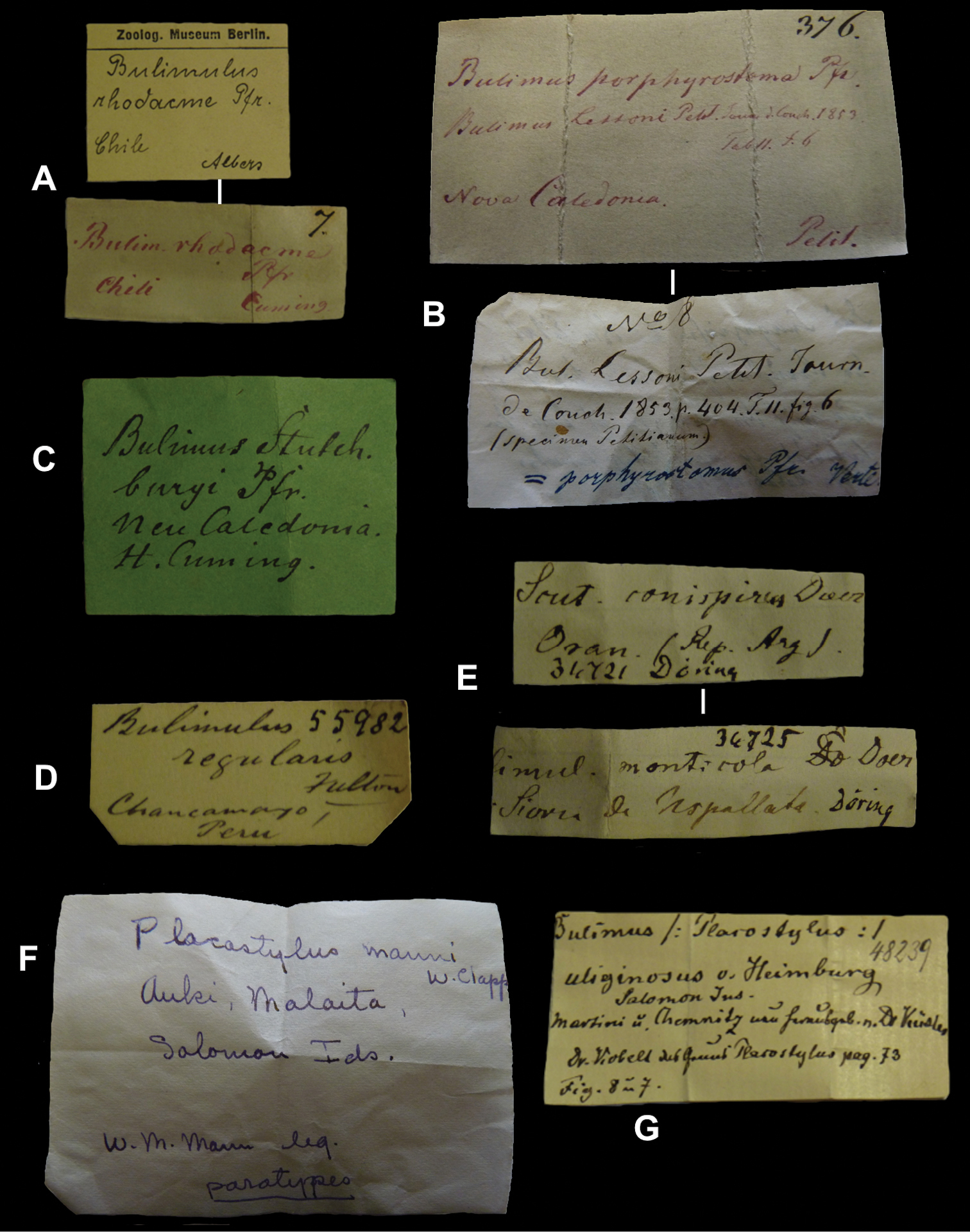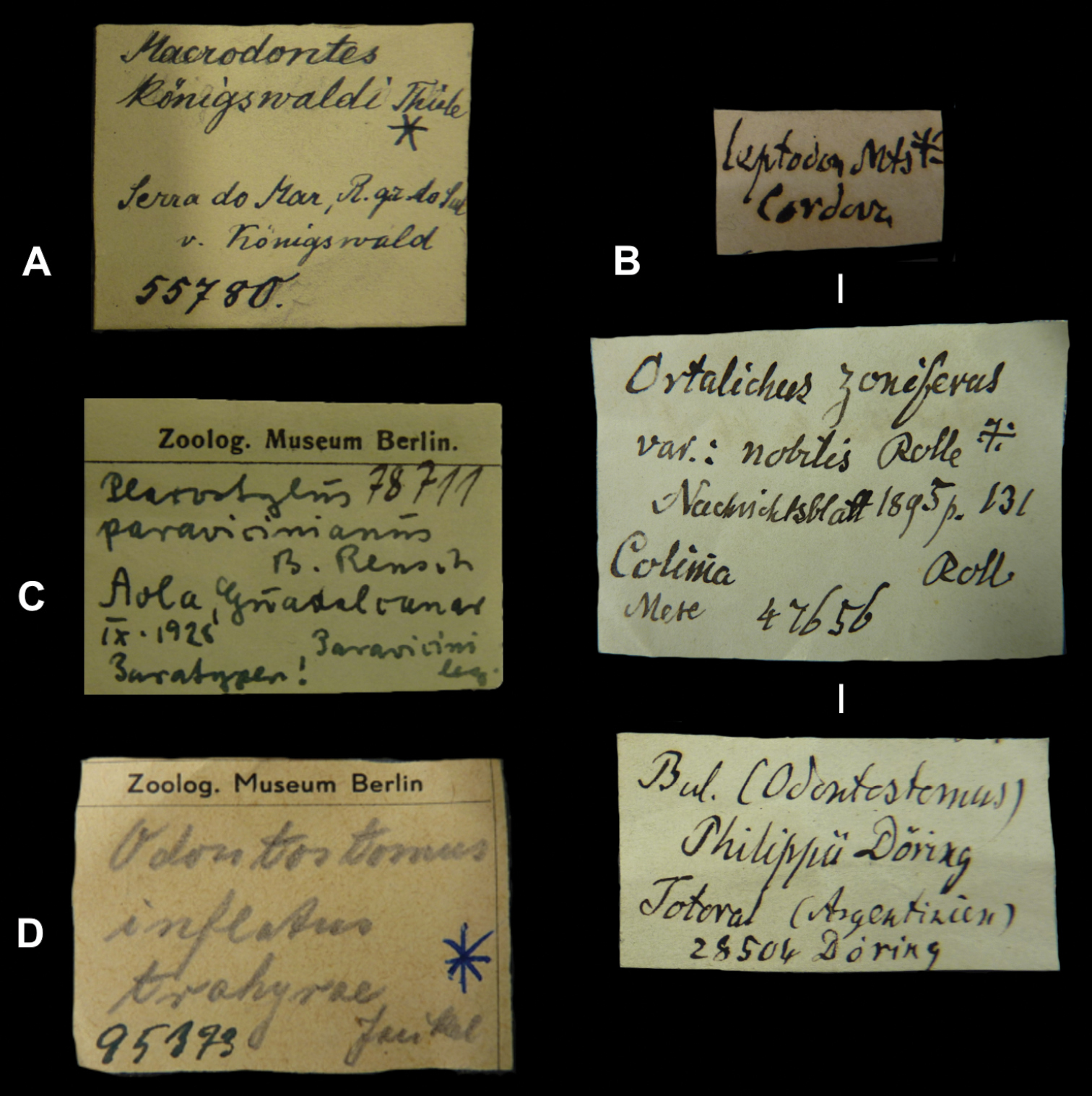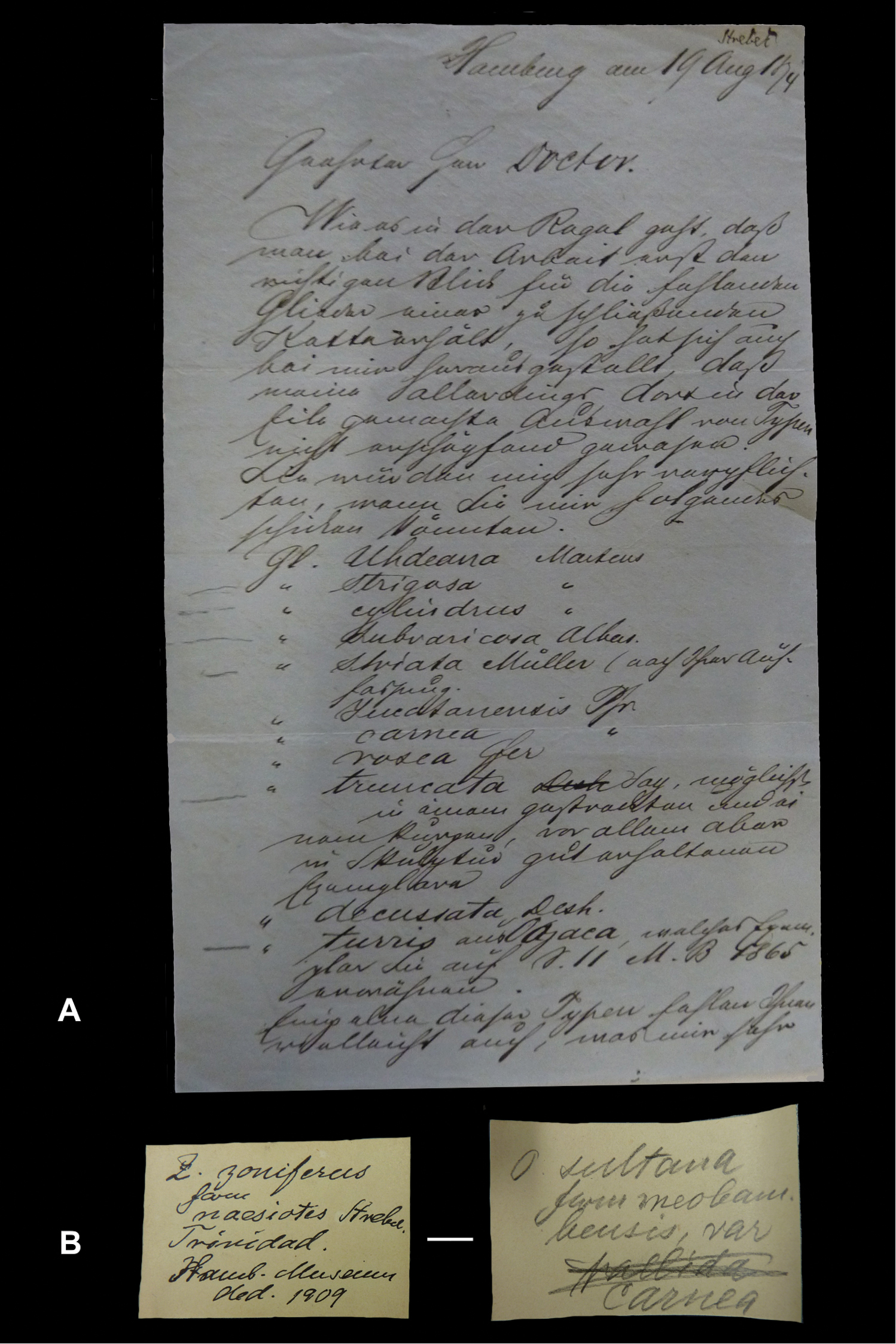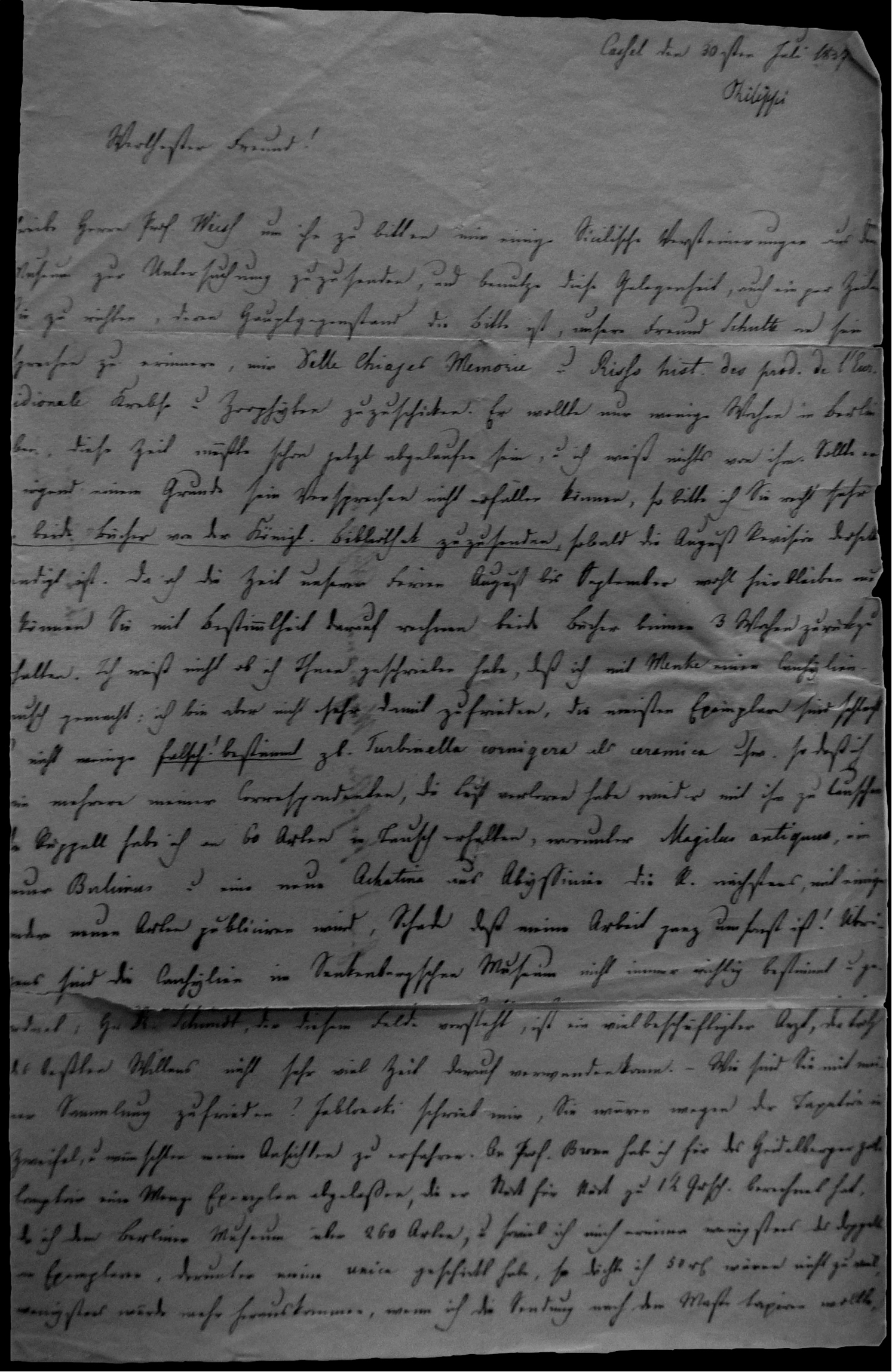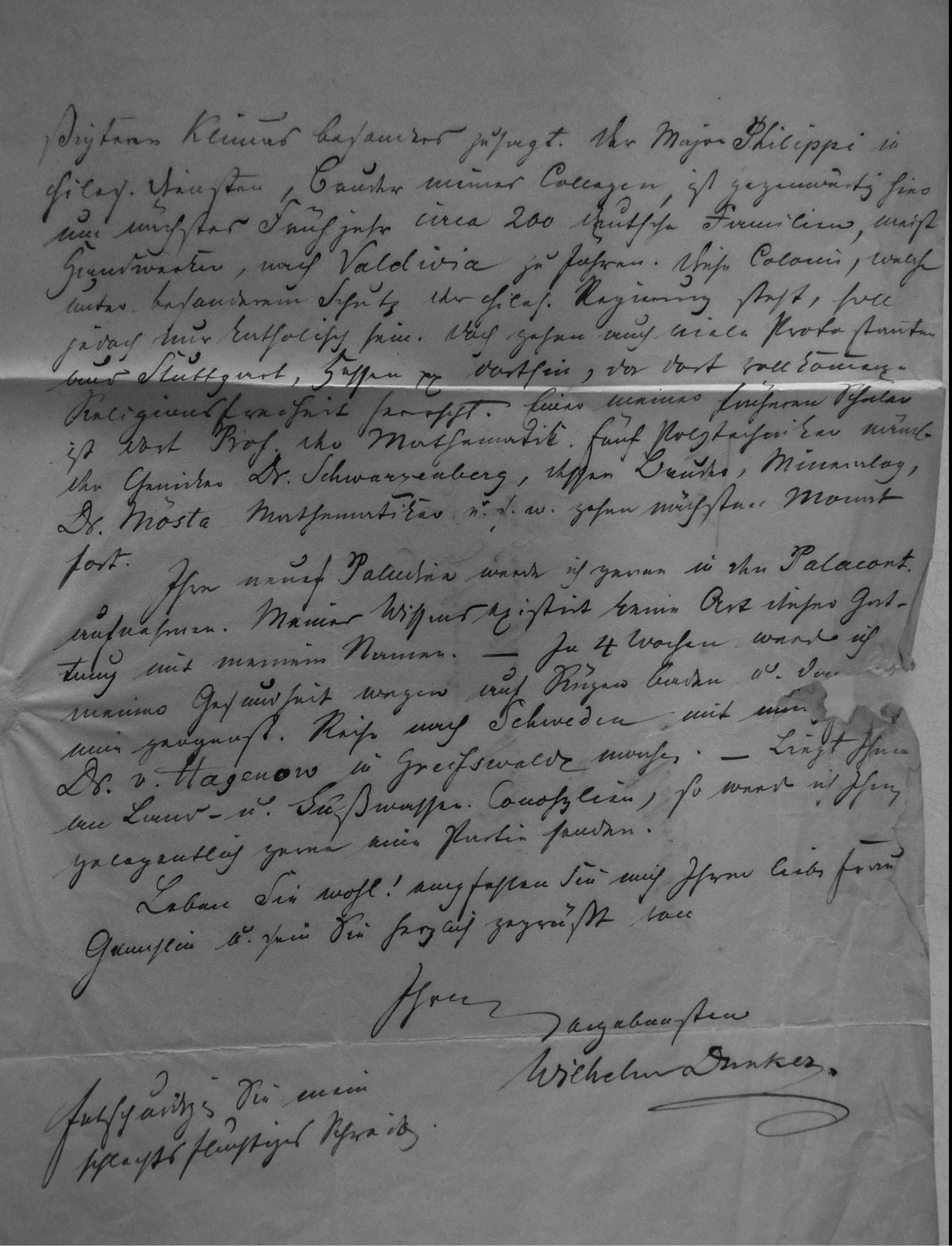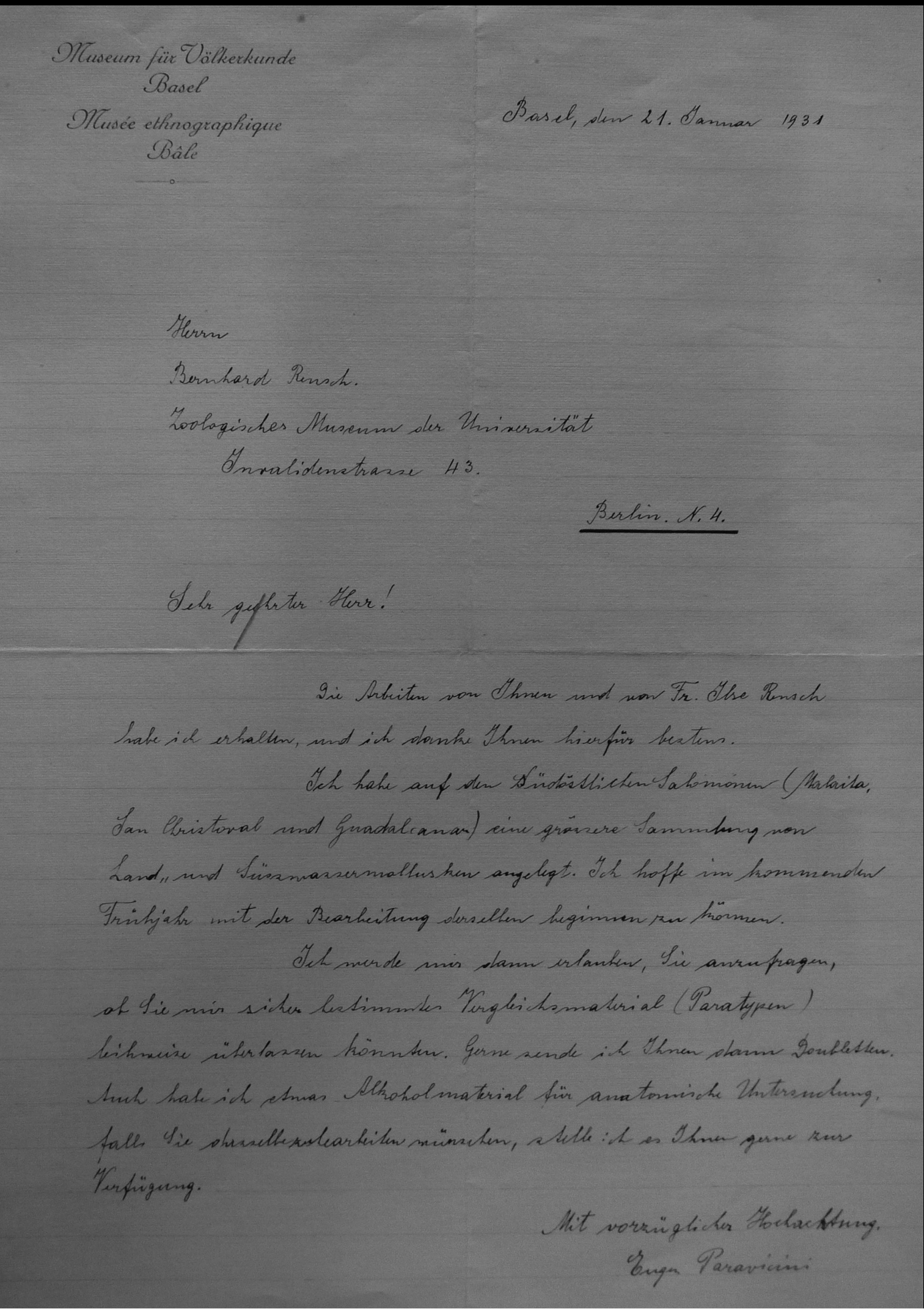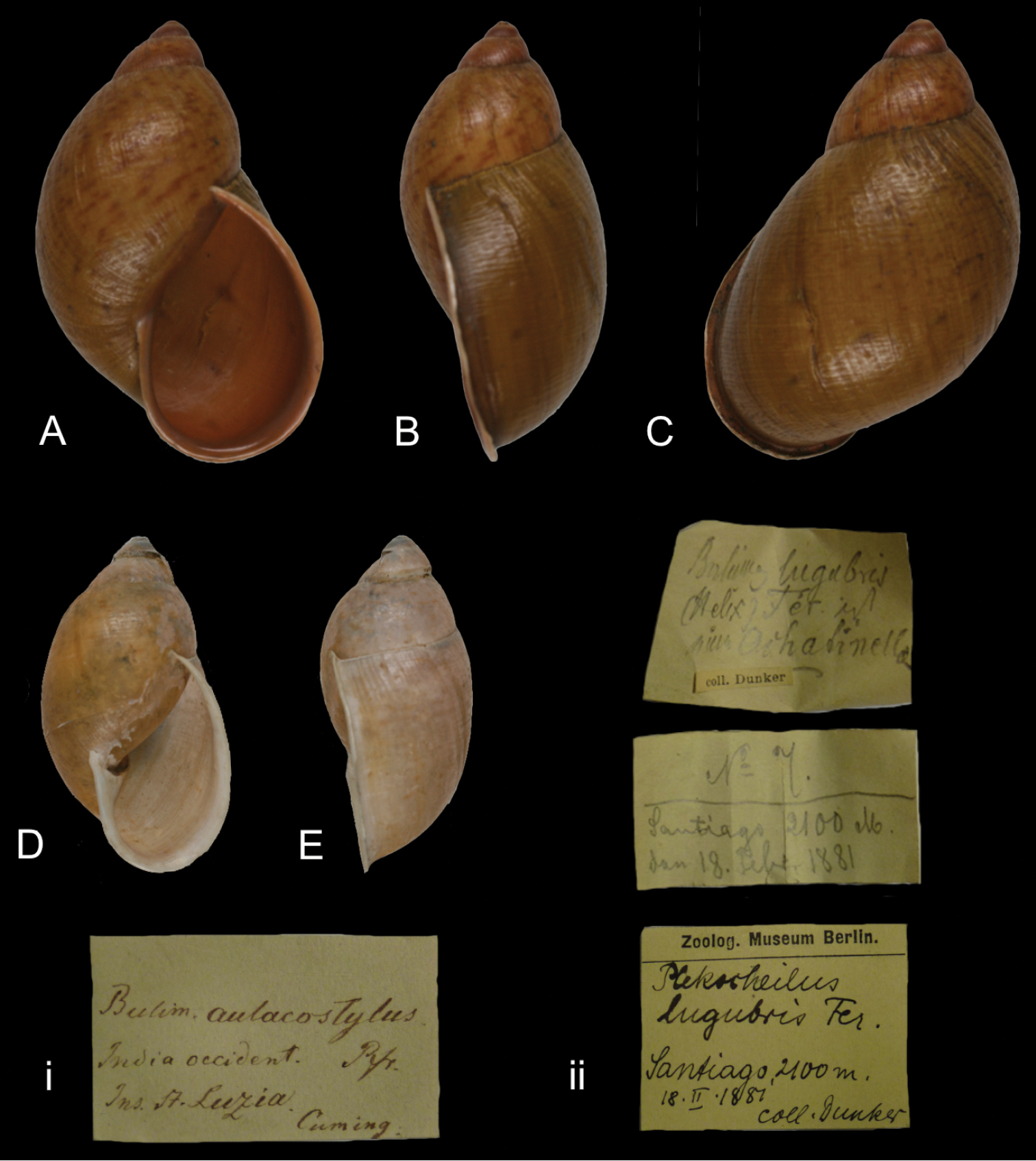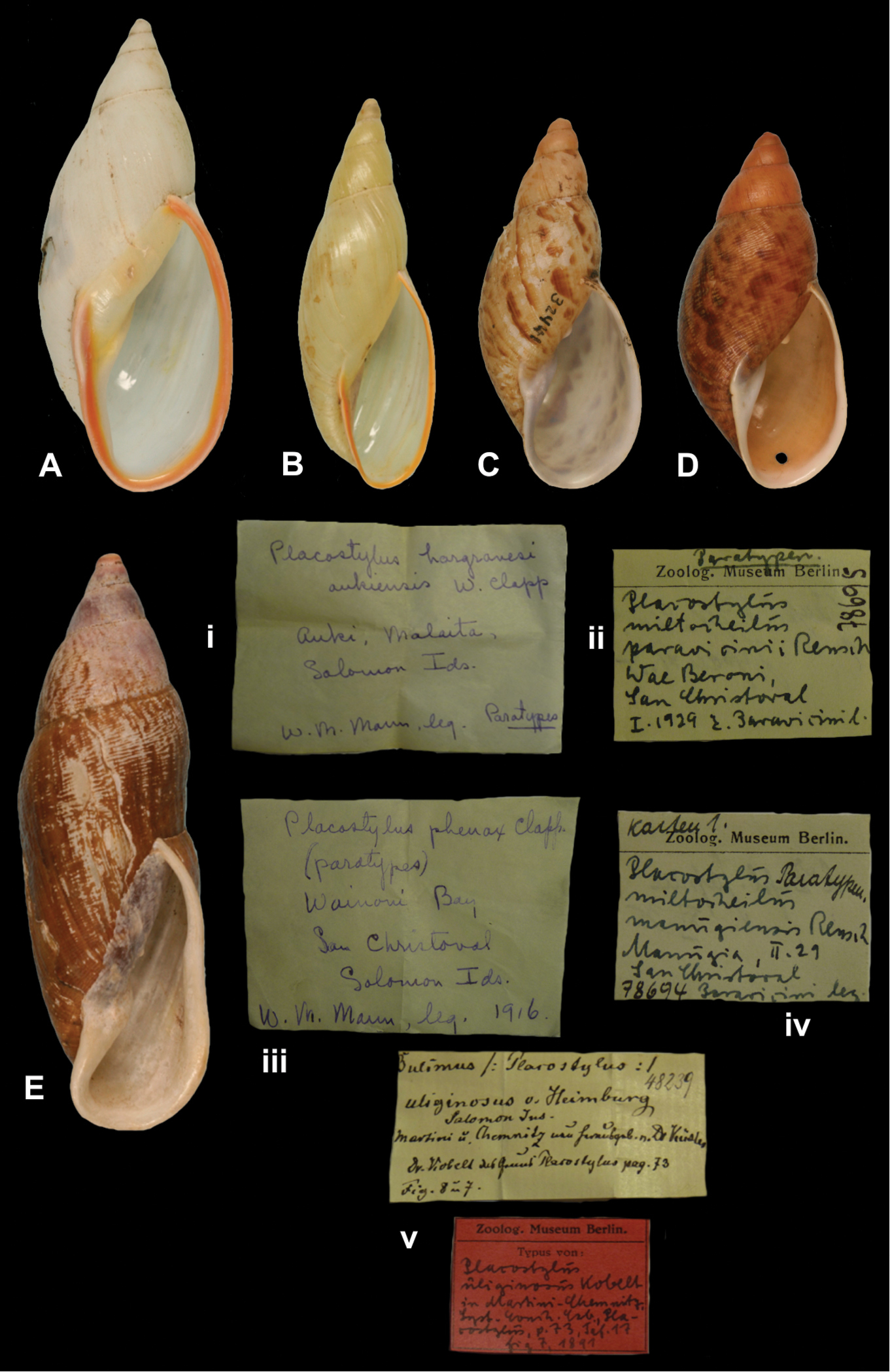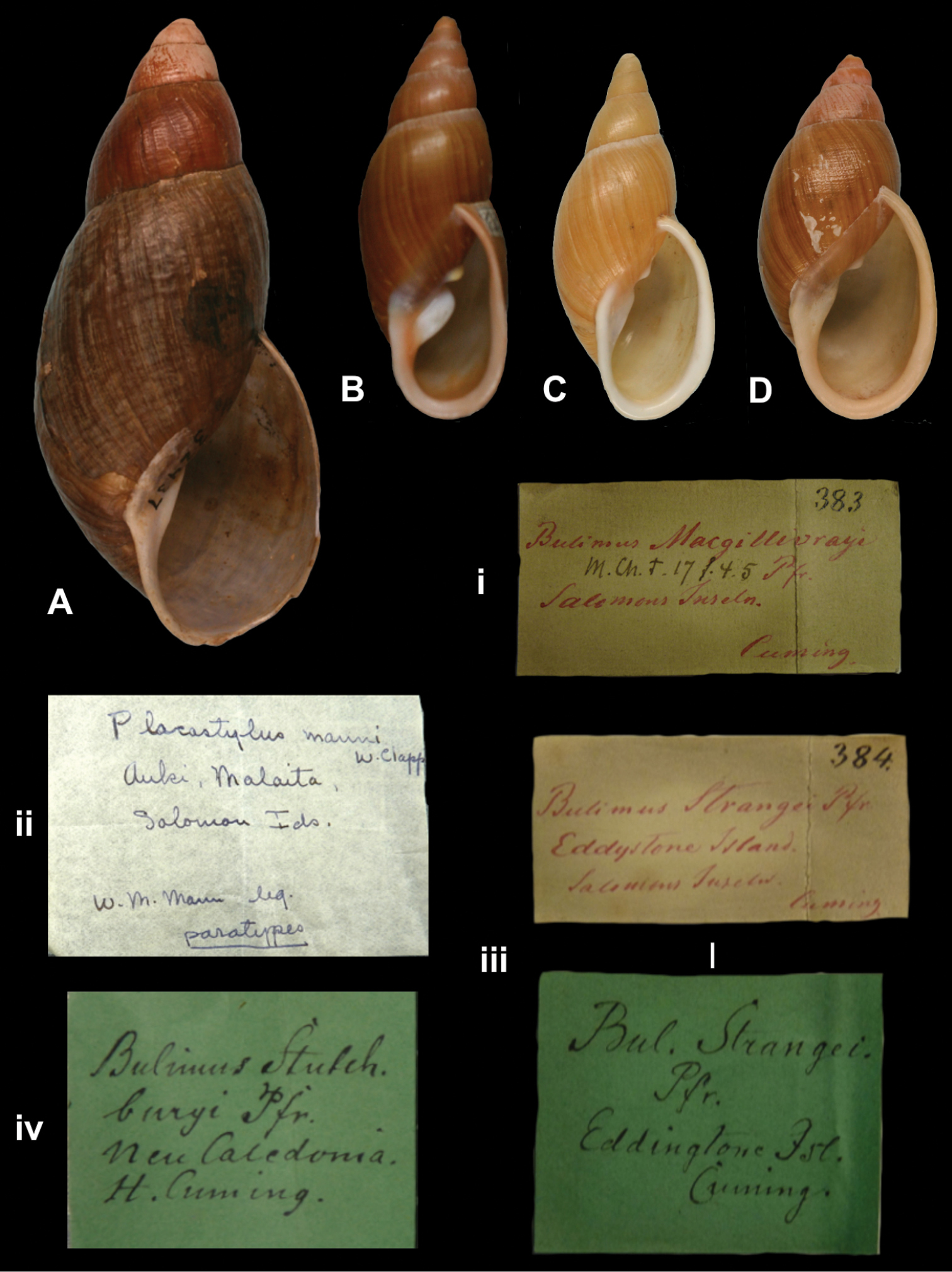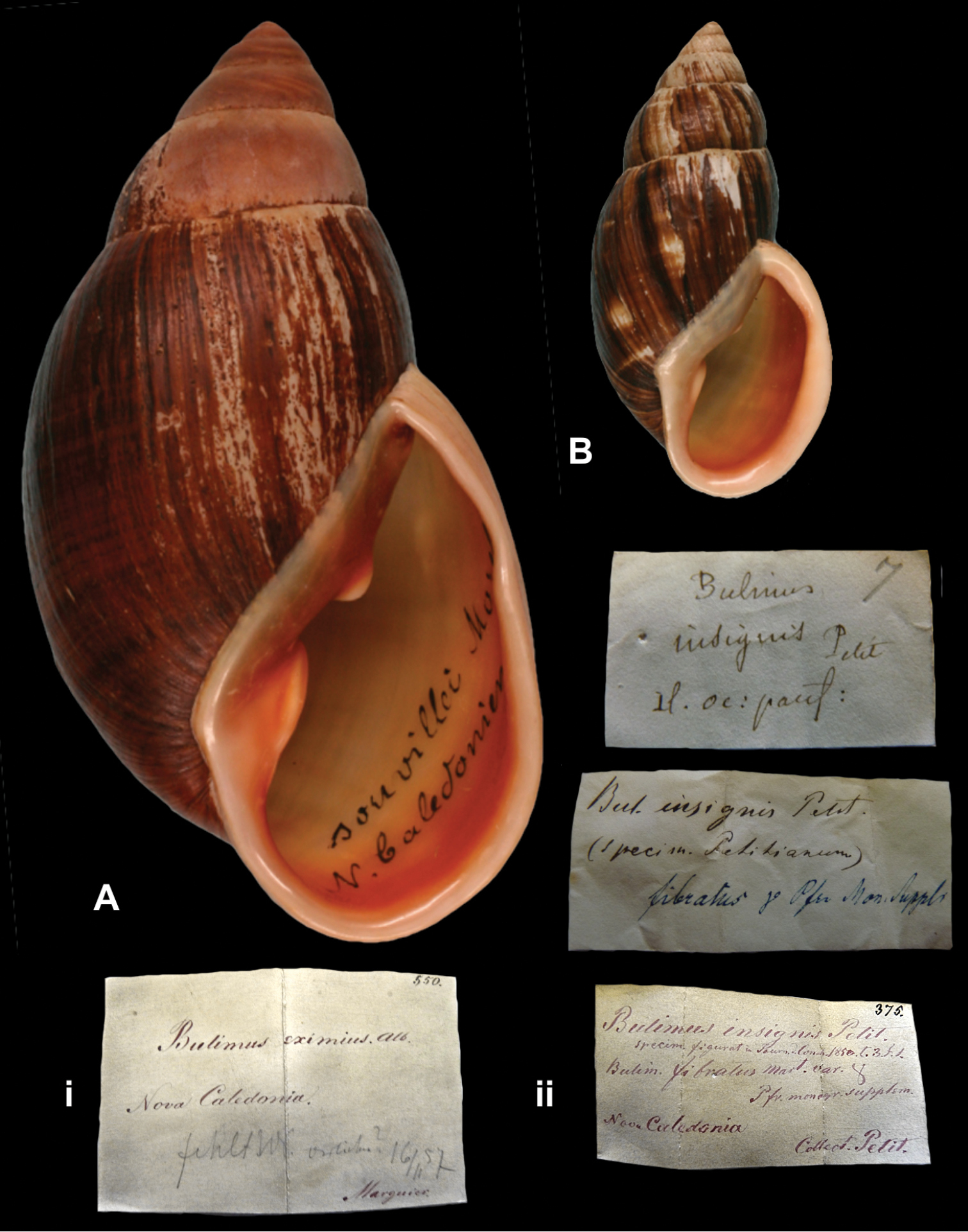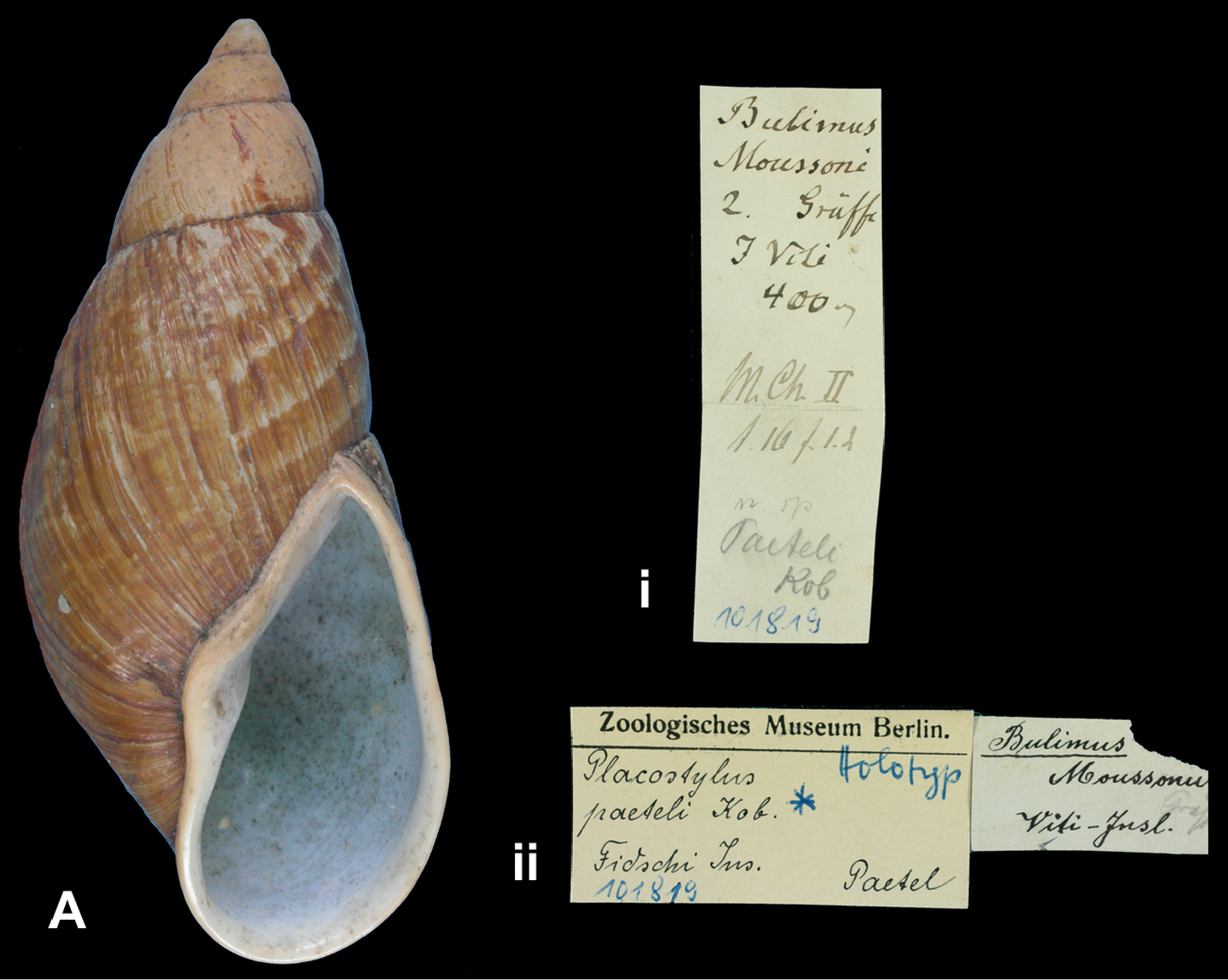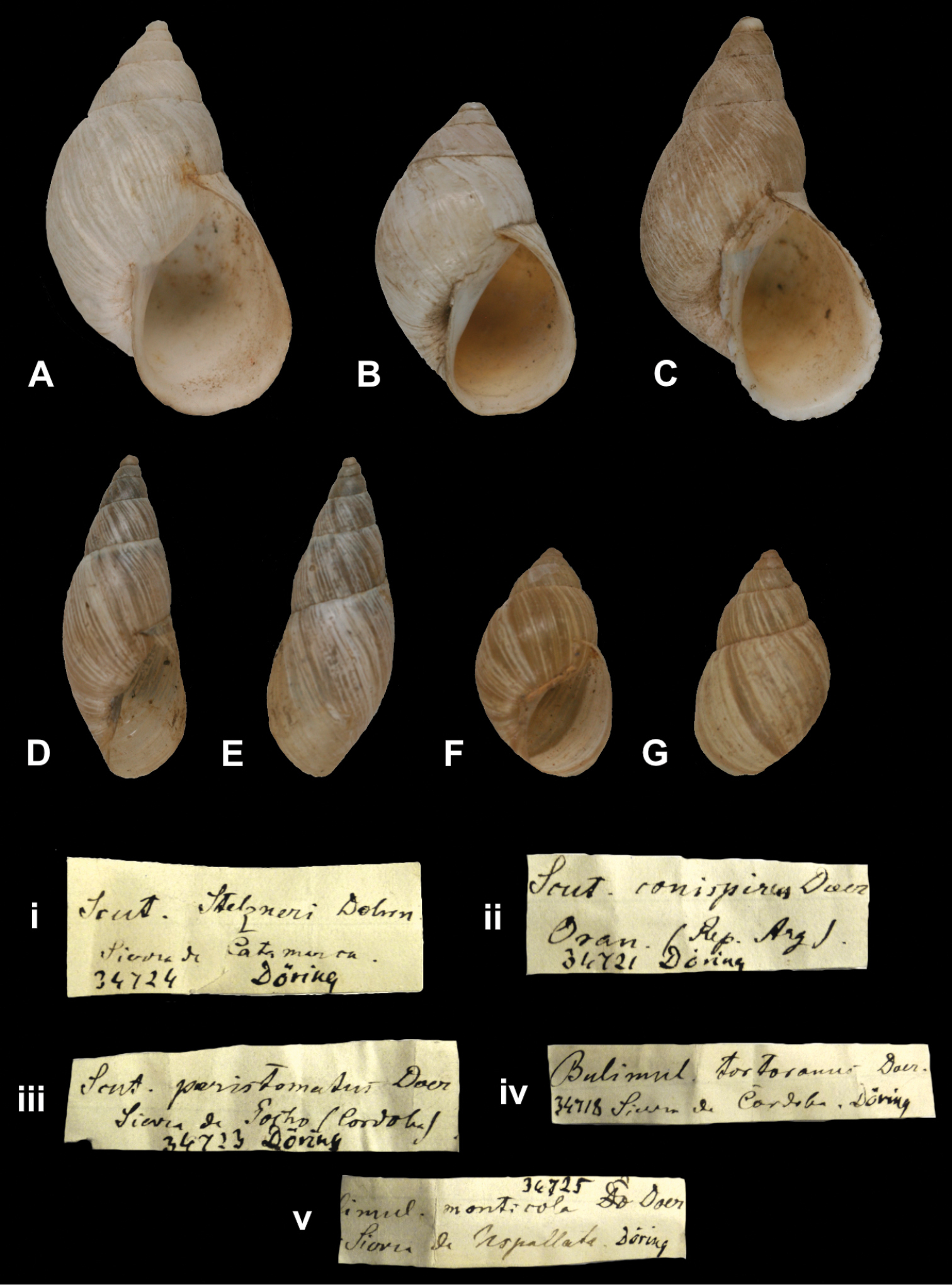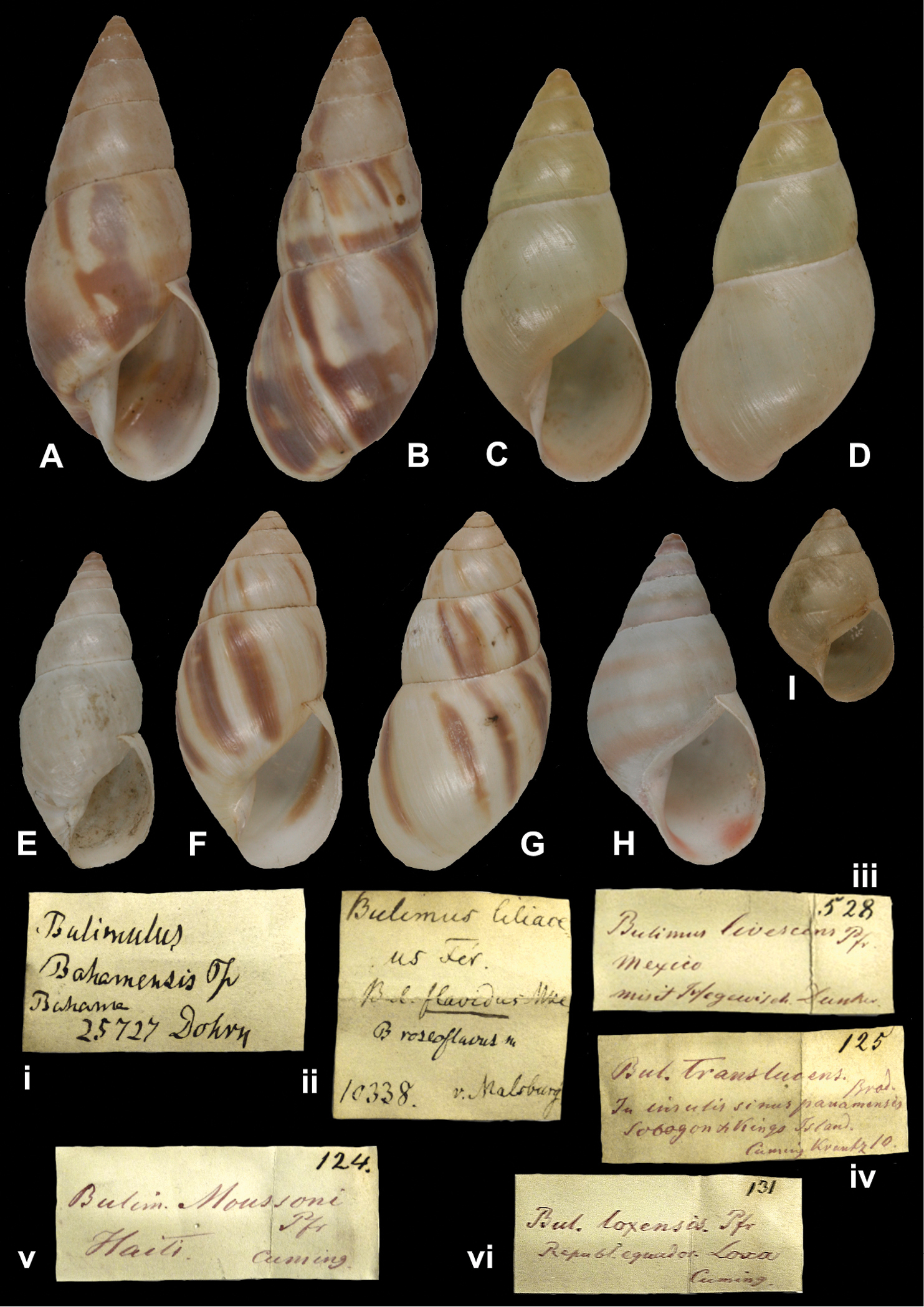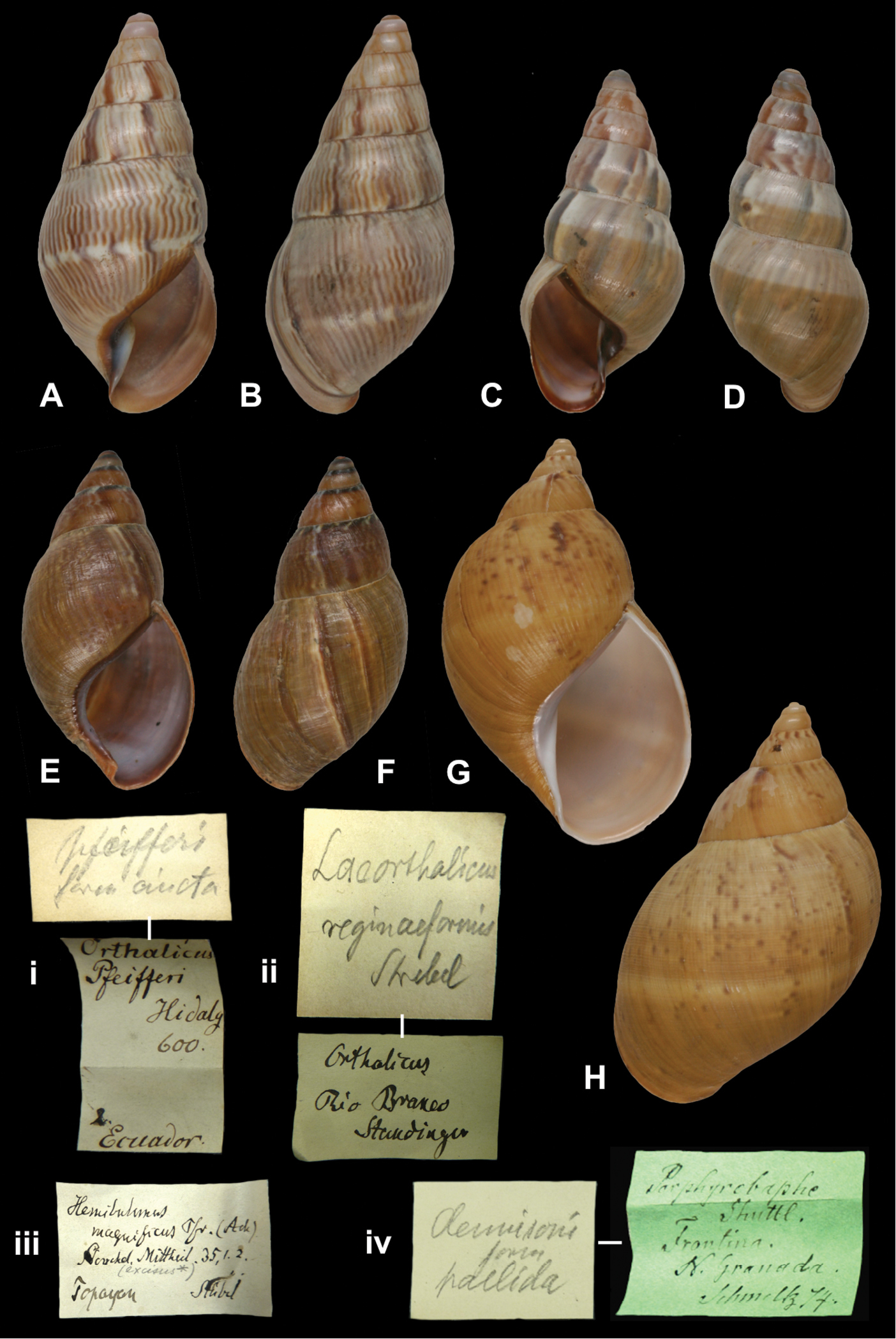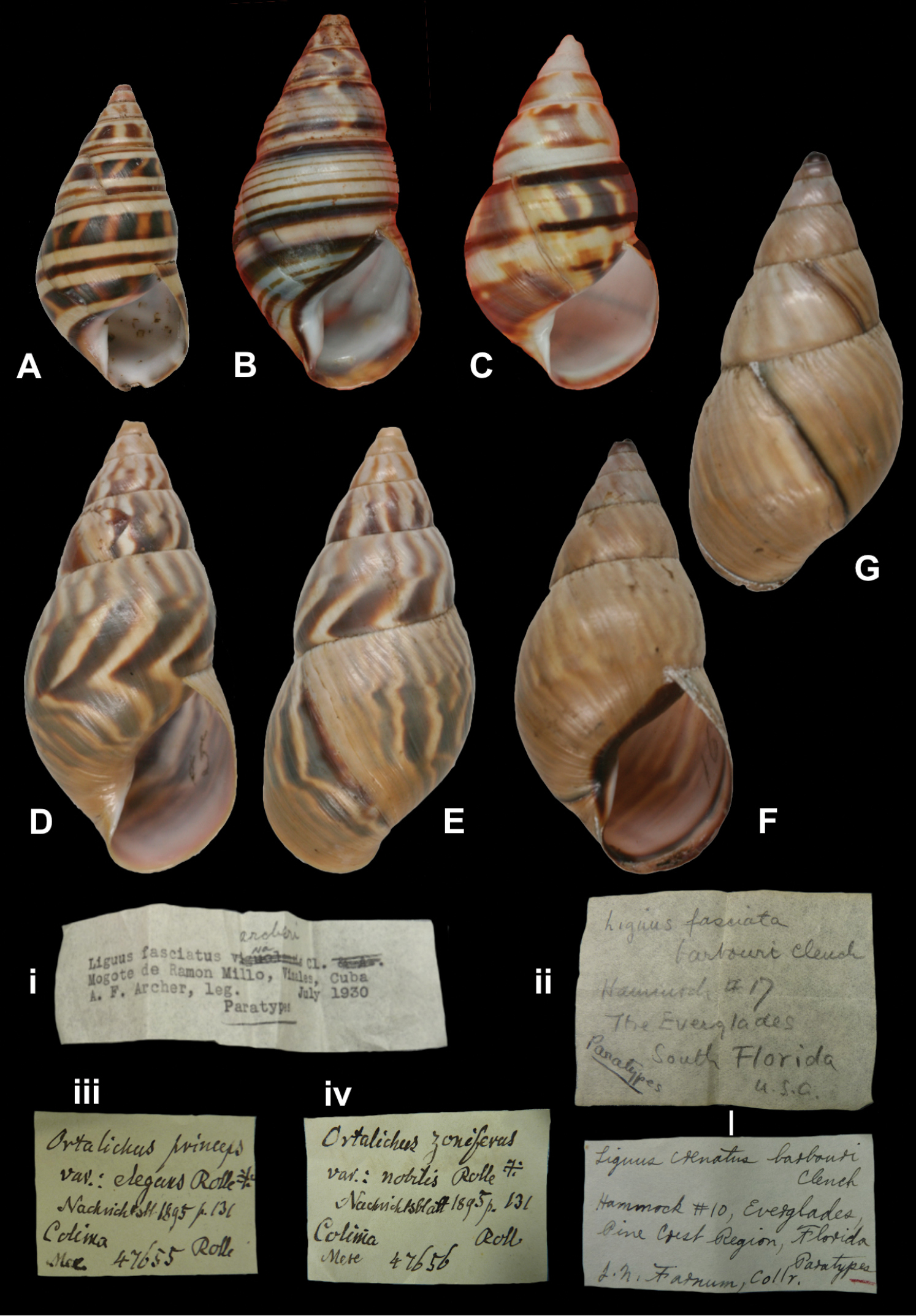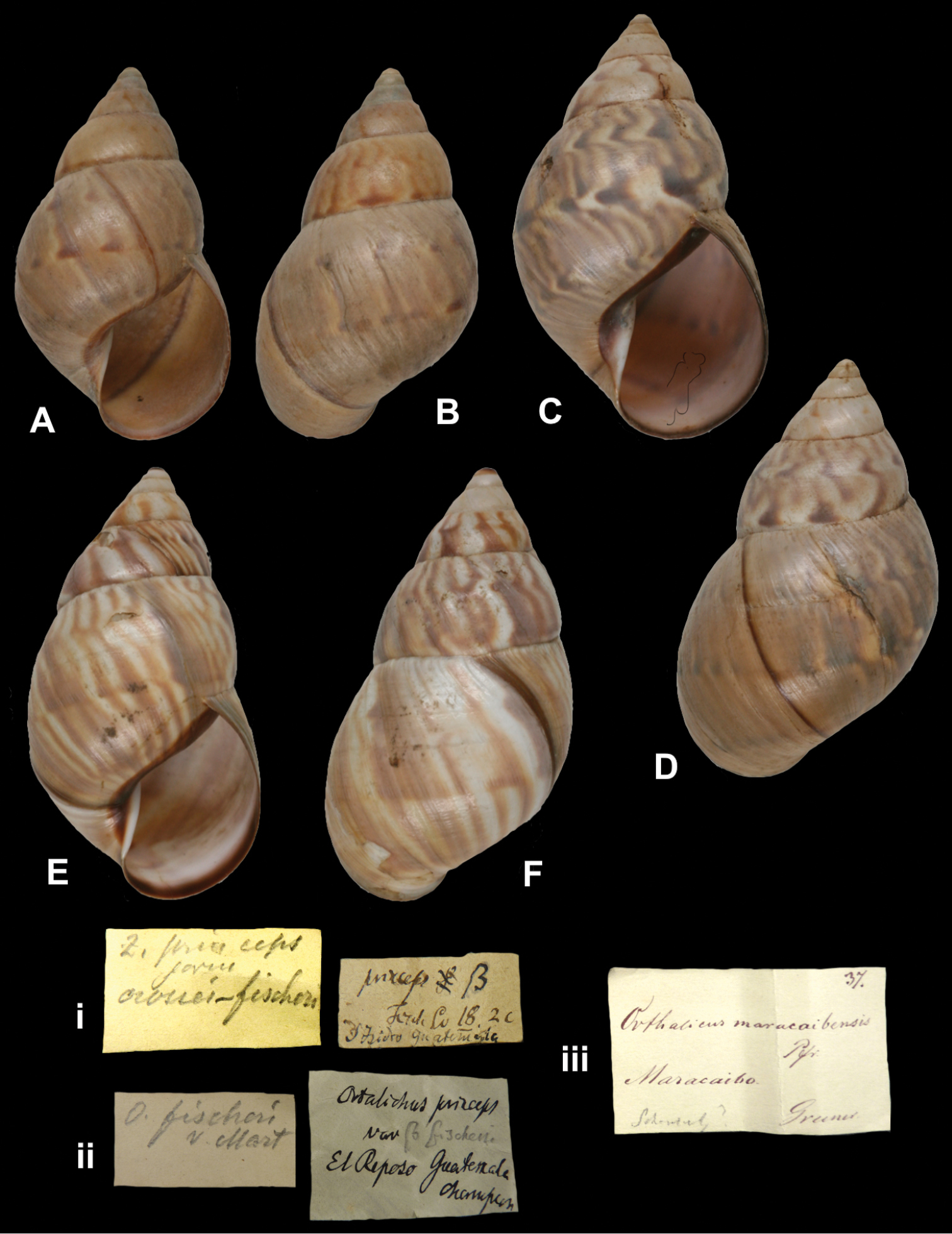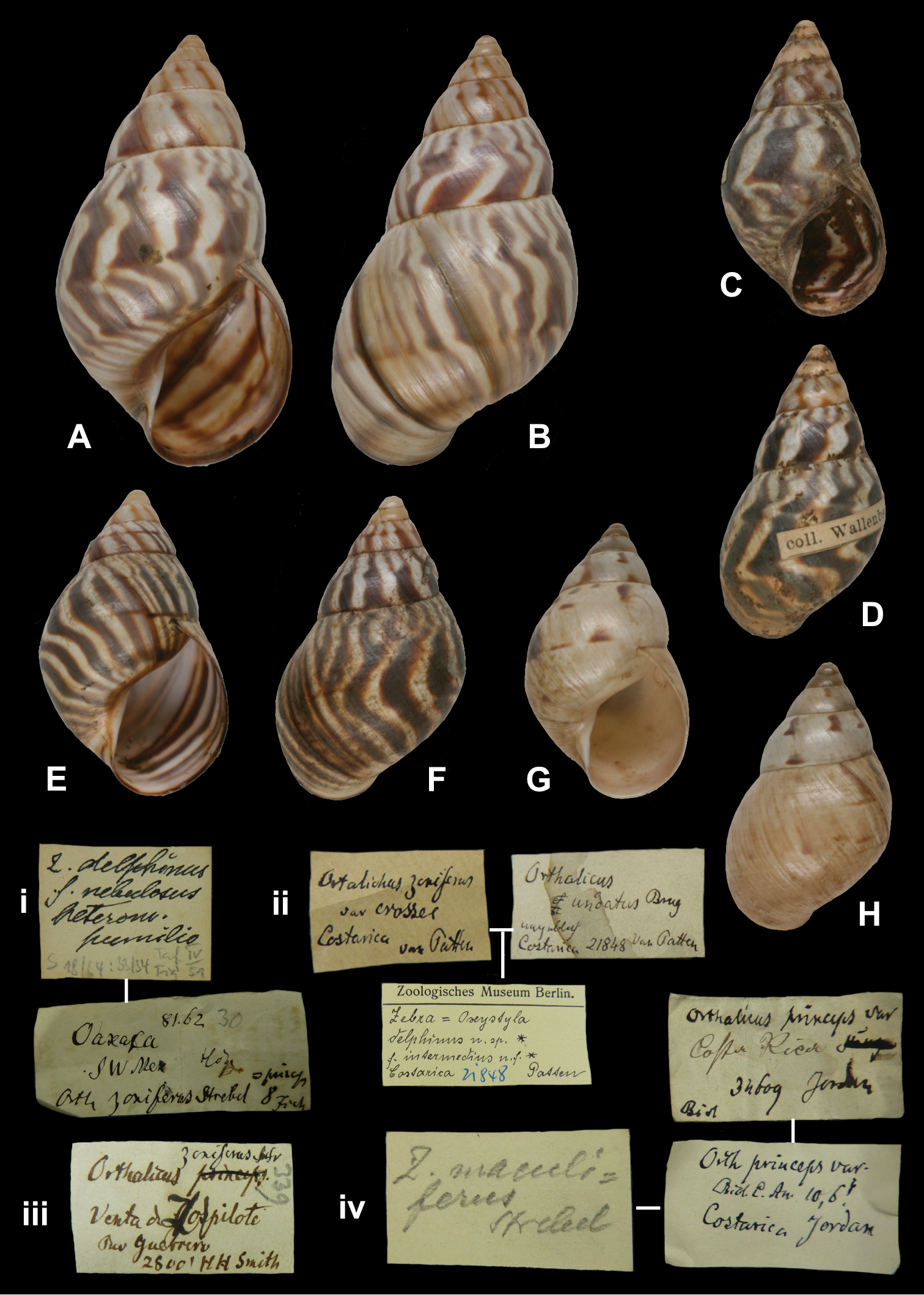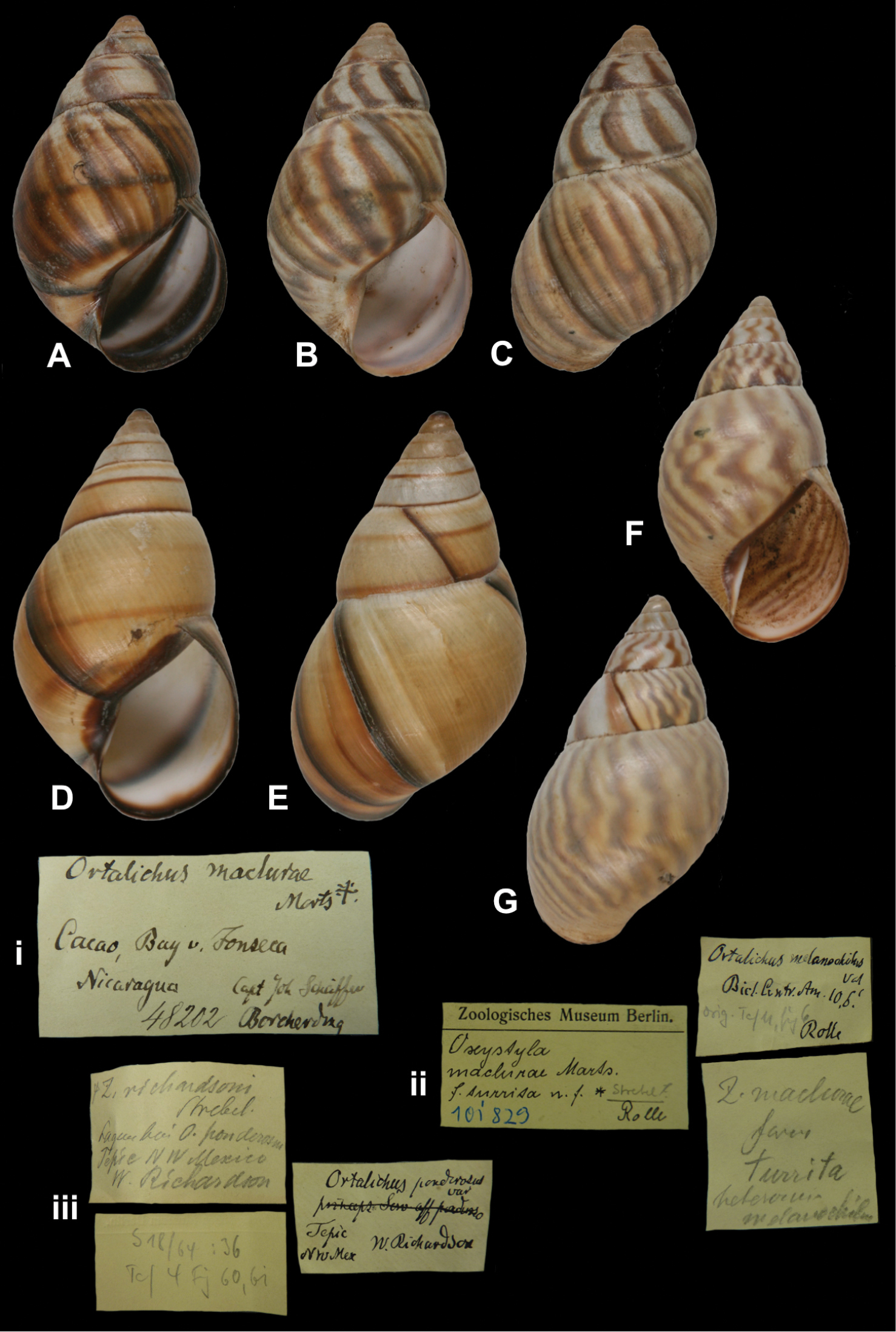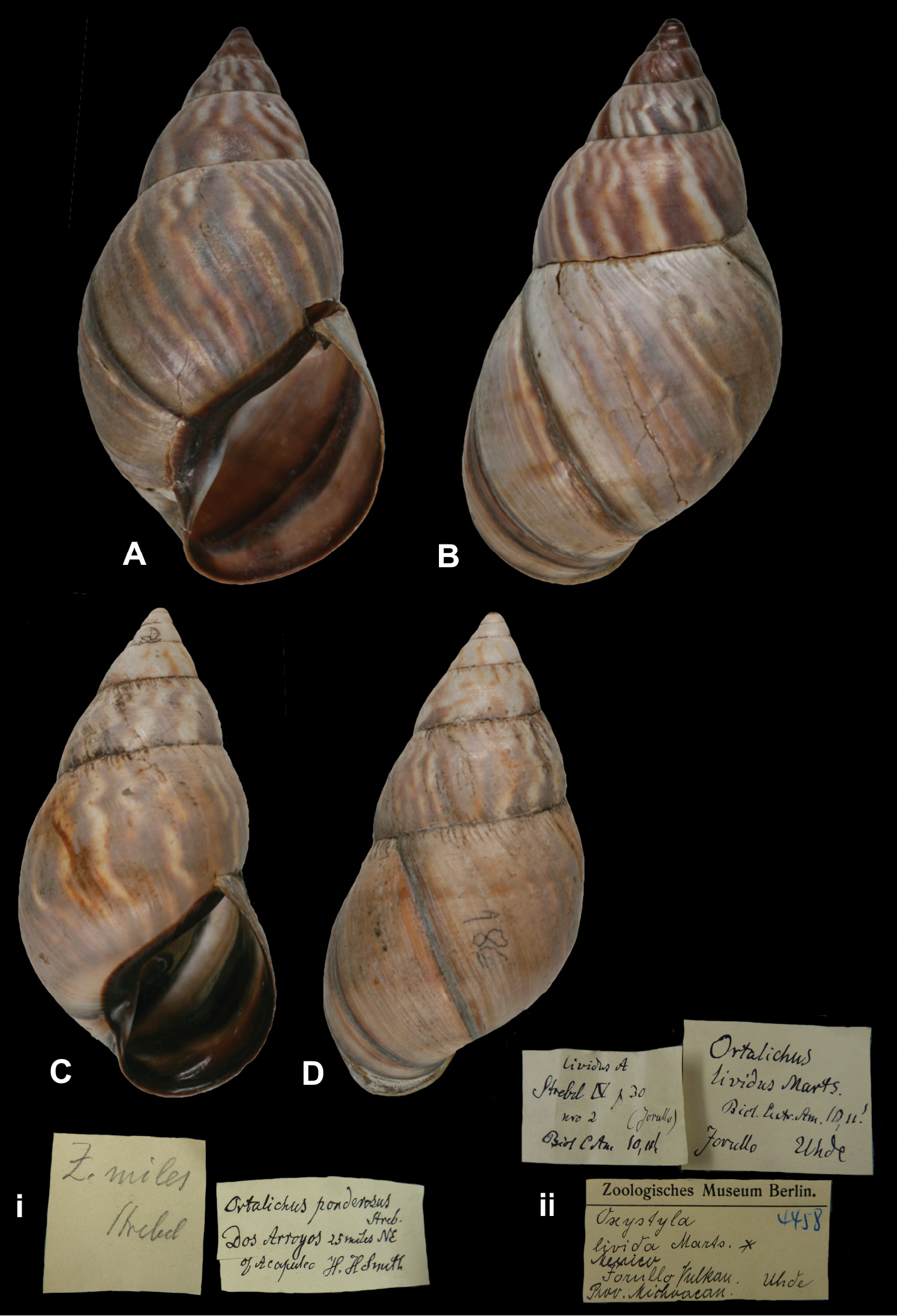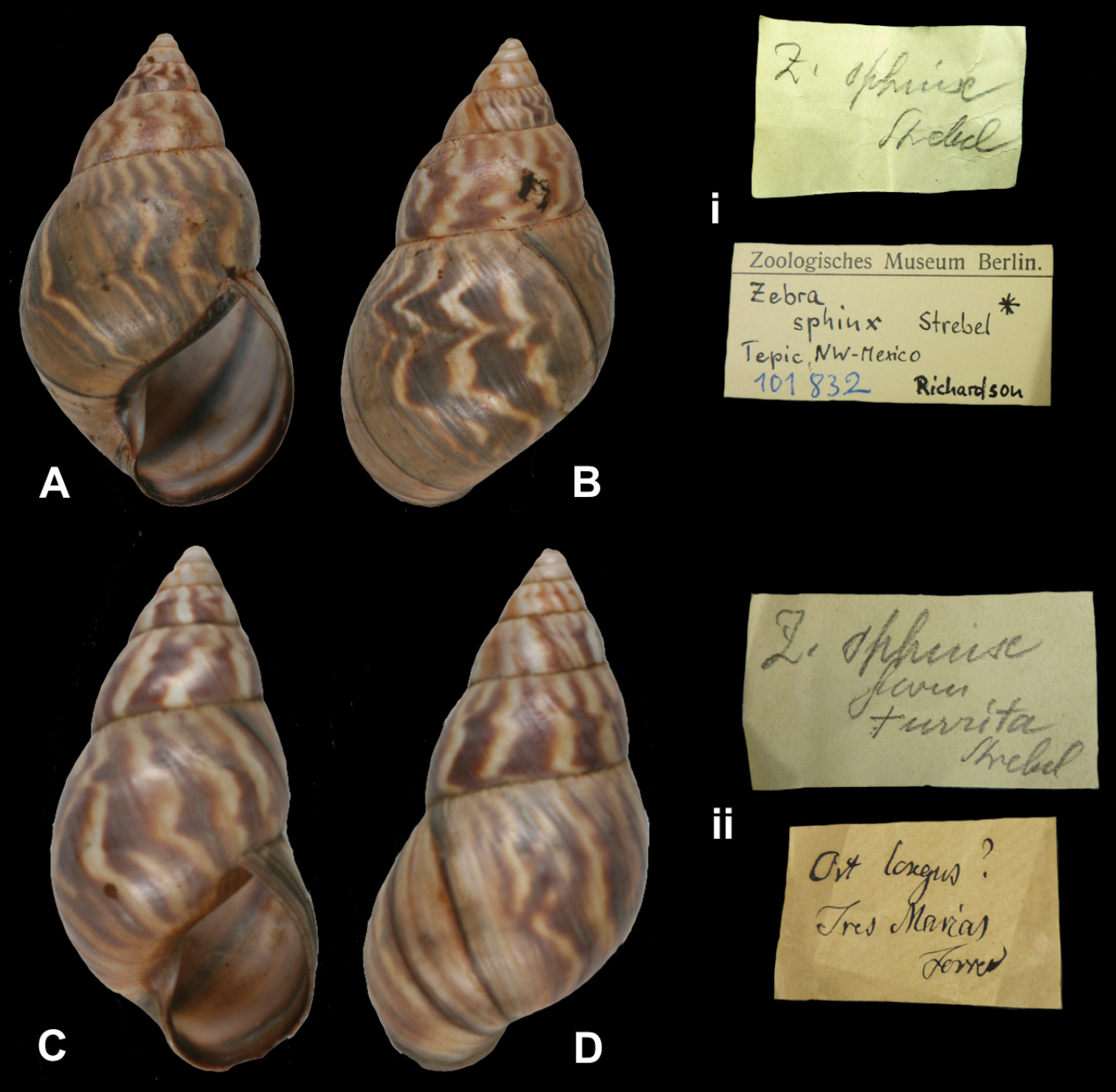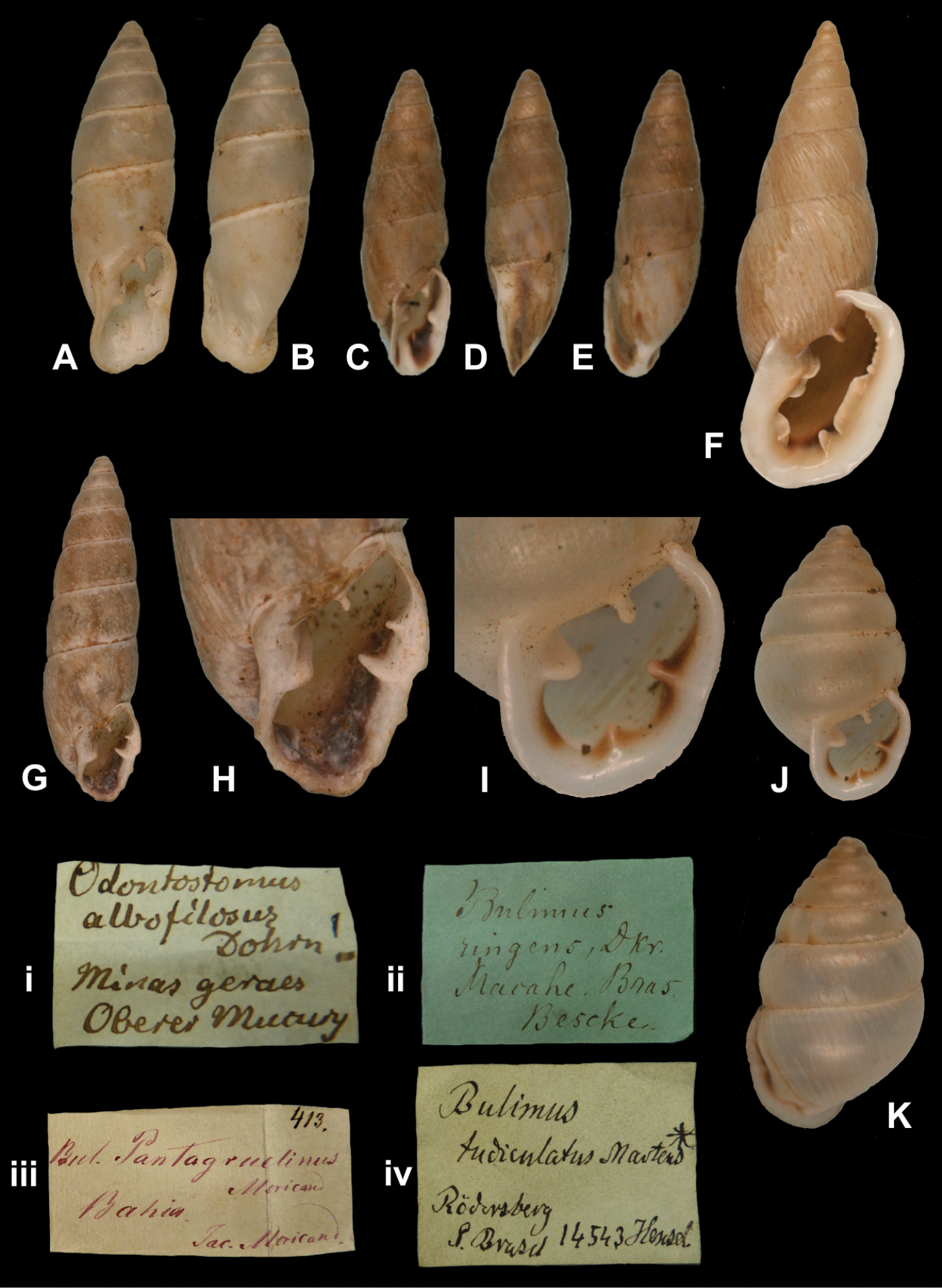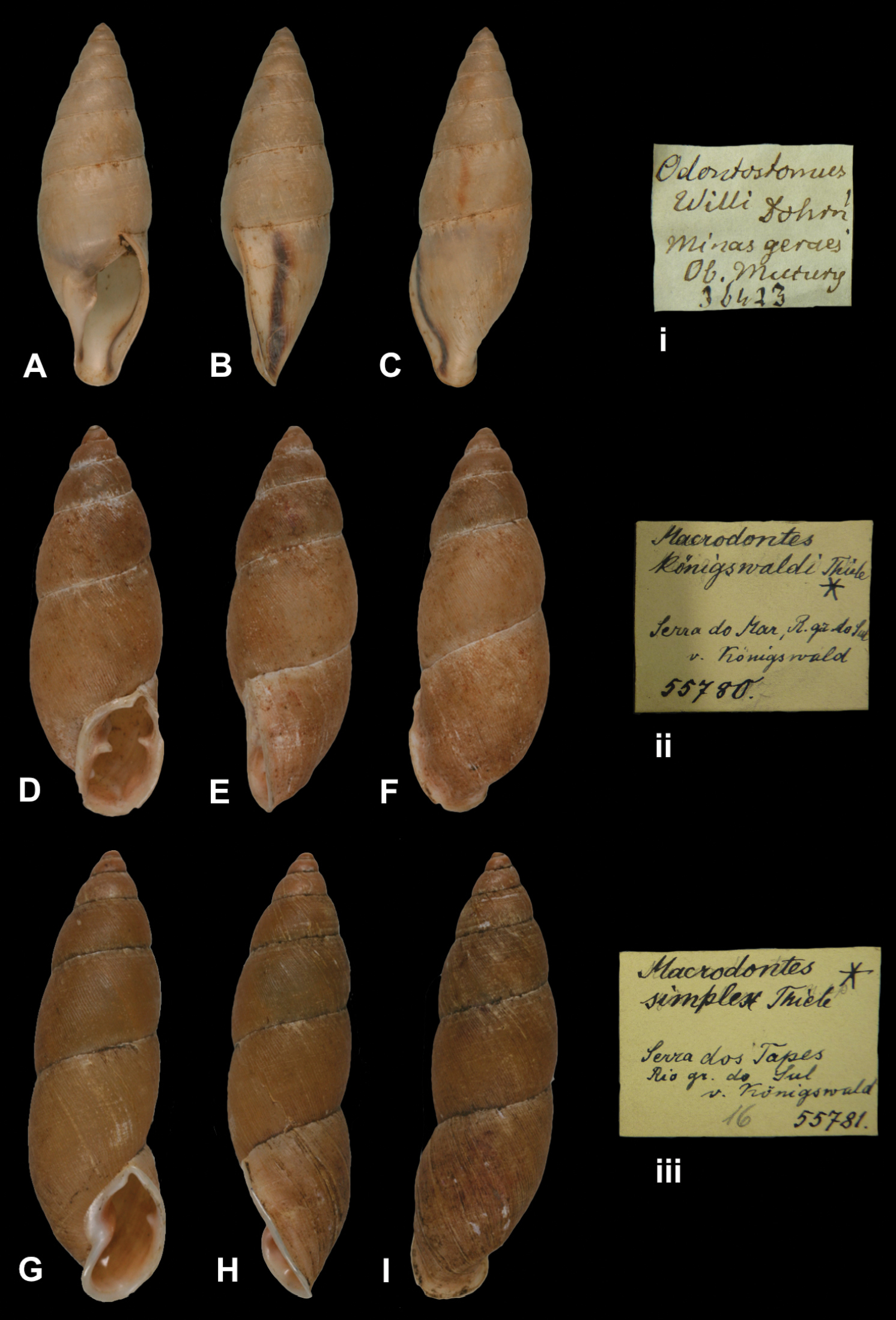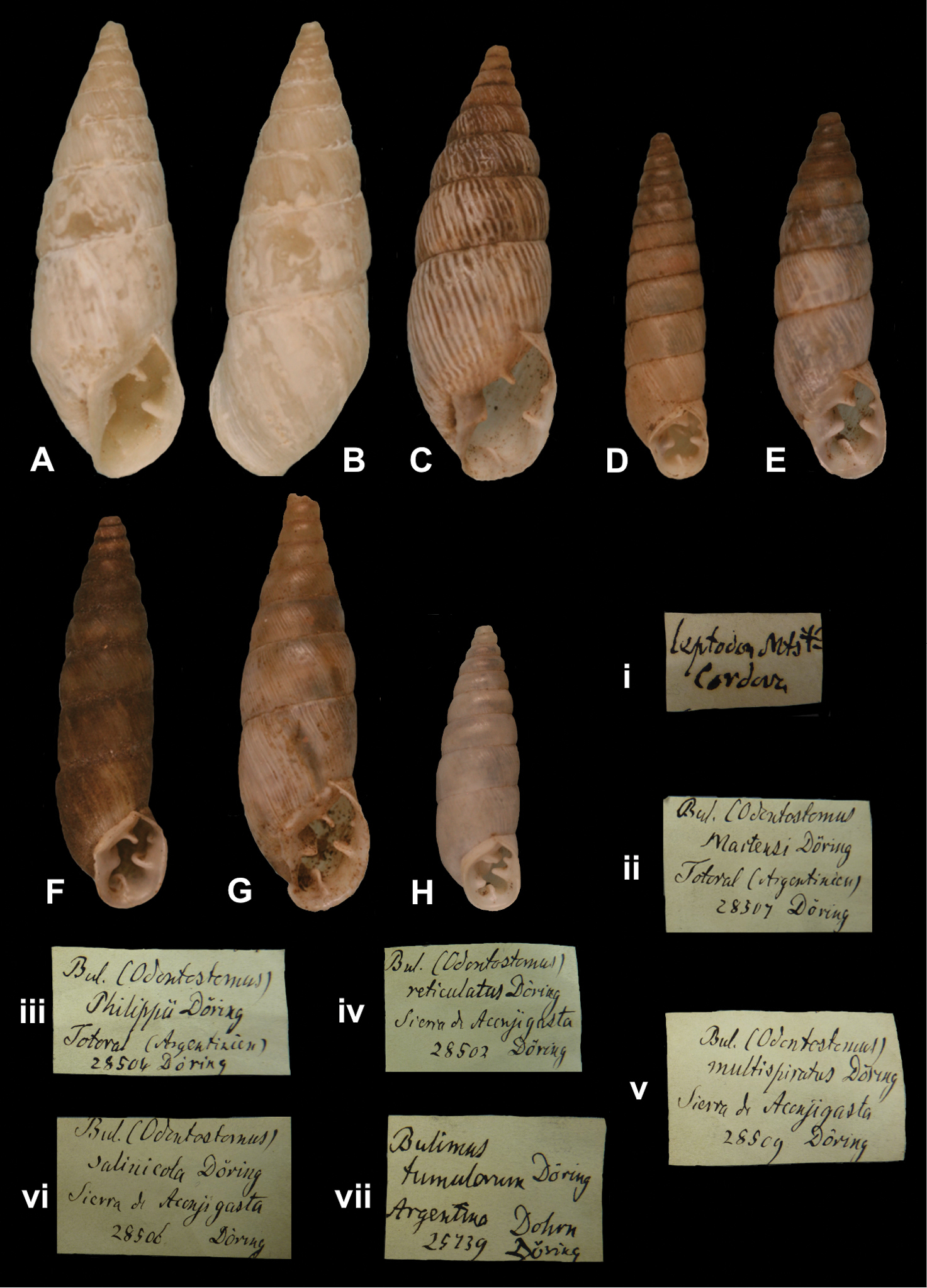






(C) 2013 Abraham S.H. Breure. This is an open access article distributed under the terms of the Creative Commons Attribution License 3.0 (CC-BY), which permits unrestricted use, distribution, and reproduction in any medium, provided the original author and source are credited.
For reference, use of the paginated PDF or printed version of this article is recommended.
The type status is described of 96 taxa classified within the superfamily Orthalicoidea and present in the Mollusca collection of the Museum für Naturkunde der Humboldt-Universität zu Berlin. Lectotypes are designated for the following taxa: Orthalicus elegans Rolle, 1895; Bulimus maranhonensis Albers, 1854; Orthalicus nobilis Rolle, 1895; Orthalichus tricinctus Martens, 1893. Orthalicus sphinx tresmariae is introduced as new name for Zebra sphinx turrita Strebel, 1909, not Zebra quagga turrita Strebel, 1909. The following synonyms are established: Zebra crosseifischeri Strebel, 1909 = Orthalicus princeps fischeri Martens, 1893; Orthalicus isabellinus Martens, 1873 = Orthalicus bensoni (Reeve, 1849); Zebra zoniferus naesiotes Strebel, 1909 = Orthalicus undatus (Bruguière, 1789); Porphyrobaphe (Myiorthalicus) dennisoni pallida Strebel, 1909 = Hemibulimus dennisoni (Reeve, 1848); Zebra delphinus pumilio Strebel, 1909 = Orthalicus delphinus (Strebel, 1909); Orthalicus (Laeorthalicus) reginaeformis Strebel, 1909 = Corona perversa (Swainson, 1821); Bulimus (Eurytus) corticosus Sowerby III, 1895 = Plekocheilus (Eurytus) stuebeli Martens, 1885. The taxon Bulimus (Eudioptus) psidii Martens, 1877 is now placed within the family Sagdidae, tentatively in the genus Platysuccinea. Appendices are included with an index to all the types of Orthalicoidea extant (including those listed by
Bothriembryontidae, Bulimulidae, Megaspiridae, Odontostomidae, Orthalicidae, Simpulopsidae, type material, correspondence
A steady stream of papers on type material of the superfamily Orthalicoidea in major museums has been published during recent years (
The Orthalicoidea is a large and diverse superfamily distributed mainly in the Neotropics, but with an important Gondwanan element (
The Berlin museum (ZMB) has a history of nearly 200 years, which has resulted in a malacological collection of ca. 118000 registered lots and many unregistered ones. Some of the malacological curators had an active role in describing new orthalicoid species, viz. E. von Martens, B. Rensch, and J. Thiele (see below). However, as may be seen from the catalogue herein, these curators have been able to acquire a substantial amount of type material described by other authors, sometimes through intermediates like the shell dealer Krantz, but more relevant through the acquisition of private collections (e.g. Dunker, Albers) and the exchange of material with other institutions.
Material has been found which was collected or studied by the following persons: Johann C. Albers (1795–1857); Heinrich Dohrn (1838–1913), who exchanged material with Doering, Pfeiffer and Stelzner, cf. Dohrn (1875: 202–203); Adolfo Doering (1848–1926), who supplied type material to Dohrn and others with manuscript names before these were published, cf.
The material of H. Strebel is especially important in the context of this paper, since his own collection and the material in the Hamburg museum was destroyed during the 1940–45 war. Strebel made two major contributions to the orthalicoid literature. The first one was when he published, together with G. Pfeffer, his fifth and final volume on Mexican land shells (
The importance of handwriting recognition for the deciphering and authorship of labels in collections has recently been illustrated by
Finally, a special note may be made about the B. and I. Rensch material. They studied material obtained from E.M.M. Paravicini. He wrote to B. Rensch (letter d.d. 21.i.1931; Fig. 7) “Ich habe auf den südostlichen Salomonen (Malaita, San Christoval und Guadalcanar) eine grössere Sammlung von Land- und Süsswassermollusken angelegt. Ich hoffe in kommende Frühjahr mit der Bearbeitung derselben beginnen zu können. Ich werde mir dann erlauben, Sie anzufragen, ob Siue mir sicher bestimmter Vergleichsmaterial (Paratypen) leihweise überlassen könnten. Gerne sende ich Ihnen dann Doubletten. Auch habe ich etwas Alkoholmaterial für anatomische Untersuchung, falls Sie derselbe zubearbeiten wünschen, stelle ich es Ihnen gerne zur Verfügung”. Paravicini probably never worked on his material, but trusted this to B. and I. Rensch. It led to their publication (
The aim of this paper is to present a survey of the types of Orthalicoidea in the ZMB collection, supplementing the earlier paper of
For each taxon, the original publication—in which the taxon was proposed—is mentioned, as well as papers in which reference is made to the type material. The type locality is quoted from the original publication in the original wording and language, with clarifying notes between square brackets. As far as possible, localities have been traced with the NGA gazetteer (http://earth-info.nga.mil/gns/html/ ) or the Fuzzy gazetteer (http://isodp.hof-university.de/fuzzyg/query/ ). The name of the collector, if given in the original paper, is only mentioned (in italics) if it might give a clue about the type status of material present in the collection. The text of the original, or oldest, label is quoted, together with information from subsequent labels if containing information necessary for a correct interpretation. All labels have been photographed and are figured for future historic reference. The dimensions of the type are quoted, as given in the original paper. Dimensions of the type specimens have been taken with a digital caliper; measurements up to 10 mm have an accuracy of 0.1 mm, those above 10 mm are accurate to 0.5 mm. Due to improvements in accuracy of Vernier calipers, the measurements given herein are in several cases slightly different from those originally reported. In the case of syntypes, only the largest specimen has been measured. Under type material the ZMB-registration numbers are given; if specimens from different localities are present, the order of the lots corresponds with the information of the different labels. The number of specimens originally available, if quoted by the original author, is mentioned under remarks. Further remarks are given to describe any individual characteristics of the type specimens or any other details of the type lot. The current systematic position is given, following the generic scheme of
Publication dates of works which have been disputed in literature generally follow the collations of
Abbreviations used for depositories of material are: FML, Fundación Miguel Lillo, Tucumán, Argentina; MCZ, Museum of Comparative Zoology, Cambridge, Mass., U.S.A.; MHNG, Musée d’Histoire Naturelle, Genève, Switzerland; MNHN, Muséum nationale d’Histoire naturelle, Paris, France; NMB, Naturhistorisches Museum, Basel, Switzerland; NHMUK, Natural History Museum, London, U.K.; RBINS, Royal Belgian Institute of Natural Sciences, Brussels, Belgium; SMF, Senckenberg Natur-Museum, Frankfurt am Main, Germany; UF, Florida Museum of Natural History, Gainesville, U.S.A.; ZMB, Museum für Naturkunde der Humboldt-Universität, Berlin, Germany; ZMZ, Zoologisches Museum, Universität Zürich, Switzerland. Other abbreviations used are: / end of line in cited text; coll., collection; D, diameter; H, shell height; leg., legit, collected; W, number of whorls. For the way measurements on the shell have been taken, see
The data underpinning the analyses reported in this paper are deposited in the Dryad Data Repository at doi: 10.5061/dryad.25g11
This systematic list follows
Family Amphibulimidae P. Fischer, 1873
Plekocheilus (Eurytus) Albers, 1850
aulacostylus Pfeiffer, 1853; lugubris Dunker, 1882; stuebeli Martens, 1885.
Family Bothriembryontidae Iredale, 1937
AspastusAlbers, 1850
manugiensis B. Rensch, 1934; paravicinii B. Rensch, 1934.
Callistocharis Pilsbry, 1900
paeteli Kobelt, 1891
Eumecostylus Martens, 1860
aukiensis W.F. Clapp, 1923; phenax W.F. Clapp, 1923; uliginosus Kobelt, 1890.
Placocharis Pilsbry, 1900
macgillivrayi Pfeiffer, 1855; manni W.F. Clapp, 1923; strangei Pfeiffer, 1855; stutchburyi Pfeiffer, 1860.
Placostylus Beck, 1837
eximius Albers, 1857; insignis Petit, 1850; scarabus Albers, 1854.
Family Bulimulidae Tryon, 1867
Bostryx Troschel, 1847
conospirus Doering, 1879; laurentii Sowerby I, 1833; monticola Doering, 1879; peristomatus Doering, 1879; rhodacme Pfeiffer, 1842; rhodolarynx Reeve, 1849; stelzneri Dohrn, 1875; terebralis Pfeiffer, 1842; tortoranus Doering, 1879.
Bulimulus Leach, 1814
coriaceus Pfeiffer, 1857; monachus Pfeiffer, 1857.
Cochlorina Jan, 1830
involutus Martens, 1867.
Drymaeus (Mesembrinus) Albers, 1850
bahamensis Pfeiffer, 1862; flavidus Menke, 1829; livescens Pfeiffer, 1842; loxensis Pfeiffer, 1846; moussoni Pfeiffer, 1853; translucens Broderip in Broderip & Sowerby I, 1832.
Lopesianus Weyrauch, 1958
crenulatus Weyrauch, 1958.
Remarks. This taxon is not represented by type material but by topotypes; the holotype and one paratype are present in the SMF collection (
Family Orthalicidae Martens, 1860
Corona Albers, 1850
cincta Strebel, 1909; reginaeformis Strebel, 1909.
Hemibulimus Martens, 1885
excisus Martens, 1885; pallida Strebel, 1909.
Liguus Montfort, 1810
archeri Clench, 1934; barbouri Clench, 1929; blainianus Poey, 1853.
Orthalicus Beck, 1837
crosseifischeri Strebel, 1909; elegans Rolle, 1895; euchrous Strebel, 1909; ferussaci Martens, 1864; fischeri Martens, 1893; gruneri Strebel, 1909; isabellinus Martens, 1873; jamaicensis Strebel, 1909; lividus Martens, 1864; maclurae Martens, 1893; maculiferus Strebel, 1909; miles Strebel, 1909; naesiotes Strebel, 1909; nobilis Rolle, 1895; richardsoni Strebel, 1909; selectus Strebel, 1909; sphinx Strebel, 1909; tricinctus Martens, 1893; (maclurae) turrita Strebel, 1909; (sphinx) turrita Strebel, 1909; uhdeanus Martens, 1893; varius Martens, 1873; xanthus Strebel, 1909.
Sultana (Metorthalicus) Pilsbry, 1899
carnea Strebel, 1909; maranhonensis Albers, 1854; shuttleworthi Albers, 1854.
Family Odontostomidae Pilsbry and Vanatta, 1894
Bahiensis Jousseaume, 1877
albofilosus Dohrn, 1883; ringens Dunker, 1847.
Burringtonia Parodiz, 1944
pantagruelina Moricand, 1833.
Cyclodontina Beck, 1837
trahyrae Jaeckel, 1950; tudiculatus Martens, 1868.
Moricandia Pilsbry and Vanatta, 1898
willi Dohrn, 1883.
Odontostomus Beck, 1837
koenigswaldi Thiele, 1906; simplex Thiele, 1906.
Plagiodontes Doering, 1868
brackebuschii Doering, 1877; rocae Doering, 1881; weyenberghii Doering, 1877.
Spixia Pilsbry and Vanatta, 1898
achalana Doering, 1877; aconjigastana Doering, 1877; bergii Doering, 1877; bohlsi Martens, 1894; champaquiana Doering, 1877; leptodon Martens, 1875; martensii Doering, 1875; multispirata Doering, 1877; philippii Doering, 1875; reticulata Doering, 1877; salinicola Doering, 1877; tumulorum Doering, 1875.
Remarks.
Family Simpulopsidae Schileyko, 1999
Remarks.
The taxon Simpulopsis (Eudioptus) psidii (Martens, 1877), considered to belong to this group by
http://species-id.net/wiki/Bulimus_achalanus
Figs 32D, 32iv[Argentina, Prov. Córdoba] “Sierra de Achala (Quebrada de Musi)”.
“Sierra de Achala”, taxon label in Martens’ handwriting.
“Long. 21–27mm, lat. 6–7mm”; figured specimen herein H 21.7, D 6.9, W 9.4.
ZMB 28505, two paralectotypes; ex Doering.
The locality matches the type locality. The specimens were directly received from Doering and are herein considered type material. Doering did not mention on how many specimens his description was based upon, but the fact that he gave a range indicates that he had several specimens at hand. The lectotype and four other paralectotypes are in SMF (
Odontostomidae, Spixia achalana (Doering, 1877).
http://species-id.net/wiki/Bulimus_aconjigastanus
Figs 32E, 32vNot given [Argentina].
“Sierra de Aconjigasta”, taxon label in Martens’ handwriting.
“Long. 18–21mm, lat. 5mm”; figured specimen herein H 20.0, D 5.27, W 10.1.
ZMB 28503, two paralectotypes; ex Doering.
The locality given on the label could not be found in modern gazetteers, but is likely in Prov. Córdoba. The specimens were directly received from Doering and are herein considered type material. Doering did not mention on how many specimens his description was based upon, but the fact that he gave a range indicates that he had several specimens at hand. The lectotype and 24 other paralectotypes are in SMF (
Odontostomidae, Spixia aconjigastana (Doering, 1877).
http://species-id.net/wiki/Bulimus_albofilosus
Figs 30A–B, 30iNot specifically given. From the title and introduction it may be concluded “östlichen Brasilien (...) Quellgebiet des Mucury”.
“Minas geraes, Oberes Mucury”, in handwriting, probably not Dohrn’s.
“Long. 22-24 , diam 6 1/2-7 (...) mm”; figured specimen herein H 22.5, D 7.12, W 7.7.
ZMB 36424, one syntype; ex Dohrn.
As Dohrn mentioned a range in his measurements, he must have based his description on several specimens. Only one shell is present in the ZMB collection. The current systematic position is after
Odontostomidae, Bahiensis albofilosus (Dohrn, 1883).
http://species-id.net/wiki/Liguus_fasciatus_archeri
Figs 19B, 19i“Mogote de Ramon Milo, Viñales, Pinar del Rio, Cuba”.
“Mogote de Ramon Milo, Viñales, Cuba”, typewritten, with the name archeri—after correction—written in pencil in an unknown handwriting.
“Length 55.5 Width 25.0”; figured specimen herein H 51.9, D 26.1, W 5+.
ZMB 78796, four paratypes; ex Clench, A.F. Archer leg., vii.1930.
The holotype is MCZ 80901. The data of the specimens correspond to the original publication. The current systematic position is after
Orthalicidae, Liguus fasciatus (Müller, 1774).
http://species-id.net/wiki/Placostylus_hargravesi_aukiensis
Figs 9C, 9i[Solomon Islands] “Auki, Malaita Id.”.
“Auki, Malaita / Solomon Ids.”, in Clapp’s handwriting.
“G.d. 22 mm. alt. 54.5 mm”; figured specimen herein H 51.1, D 22.0, W 5.1.
ZMB 74853, two paratypes; W.M. Mann leg..
Bothriembryontidae, Eumecostylus hargravesi (Cox, 1871).
http://species-id.net/wiki/Bulimus_aulacostylus
Figs 8D–E, 8i[West Indies] “St. Lucia”.
“India occident. / Inz. St. Luzia”, label in Albers’ handwriting.
“Long. 37; lat. 18 mill.”; figured specimen herein H 37.6, D 21.2, W 4.8.
ZMB 112723, one probable syntype; ex Albers coll., ex Cuming coll.
Pfeiffer described this species from “Mus. Cuming”, without mentioning on how many specimens he based his description on. Type material of this taxon has not been found in the NHMUK collection (
Amphibulimidae, Plekocheilus (Eurytus) aulacostylus (Pfeiffer, 1853).
http://species-id.net/wiki/Bulimus_bahamensis
Figs 17A–B, 17i[West Indies] “New Providence insulam Bahamensium”.
“Bahama”, label in Dohrn’s handwriting.
“Long. 31; lat. 10 1/2 mill.”; figured specimen herein H 29.4, D 11.8, W 6.7.
ZMB 25727, two possible syntypes; ex Dohrn.
Pfeiffer described this species from material received from Th. Bland. It is known that Pfeiffer exchanged material with Dohrn (
Bulimulidae, Drymaeus (Mesembrinus) bahamensis (Pfeiffer, 1862).
http://species-id.net/wiki/Liguus_crenatus_barbouri
Figs 19C, 19ii“Pinecrest region, central Everglades, Fla. Hammock no. 21 (Farnum number). J.N. Farnum, collector.”.
“Hammock #17 / The Everglades / South Florida / U.S.A.” [ZMB 74876], “Hammock #10, Everglades, / Pine Crest Region, Florida” [ZMB 78792].
“Length 51.5 Width 27 (...) mm.”; figured specimen herein H 46.3, D 23.4, W 7.4.
ZMB 74876, two paratypes; ex Clench. ZMB 78792, two paratypes; ex Clench, J.N. Farnum leg.
Clench mentioned in his remarks “Found in nearly all the hammocks of the Pinecrest region”. Although Clench did not mention on how many specimens his description was based, the type status of this material is not disputed. Holotype MCZ 84527.
Orthalicidae, Liguus fasciatus (Müller, 1774).
http://species-id.net/wiki/Bulimus_bergii
Figs 32F, 32vi[Argentina, Prov. Córdoba] “a. var. de Alta Gracia [D.C. Berg leg] (...) b. Cuesta de S. Antonio (Sierra Chica), region de Coco y Moya (...) c. Cerro Salado (S. de Aconjigastana, pendiente Oeste) (...) d. Pozo de Piedra (S. de Aconjigasta, pendiente Oeste)”.
“Sierra de Aconjigasta”, taxon label in Martens’ handwriting.
“Long. 16–22mm, lat. 5–6mm”; figured specimen herein H 19.2, D 5.28, W 10.2.
ZMB 28508, two paralectotypes; ex Doering.
The locality given on the label could not be found in modern gazetteers, but is likely in Prov. Córdoba. Doering did not mention on how many specimens his description was based upon, but the fact that he gave a range indicates that he had several specimens at hand. The lectotype and five other paralectotypes are in SMF (
Odontostomidae, Spixia bergii (Doering, 1877).
http://species-id.net/wiki/Achatina_blainiana
Figs 19A, 19v[Cuba] “la loma de Rangel, á unas 30 leguas S–S.O. de la Habana”.
“294. Rangel / Gundl.”, “Cuba. Poey / Felipe Poey”.
“Long. 43 millimetros; diametro 18”; figured specimen herein H 39.0, D 18.2, W 7.3.
ZMB 117781, four probable syntypes; ex Dunker, ex Poey, J. Gundlach leg.
The locality on the label correspond with the type locality given by
Two other lots are present: ZMB 9044, three specimens; labelled “Rangel, Cuba”, J. Gundlach leg., and ZMB 294, three specimens; labelled “Rangel”, ex Dunker. Although this material is from the same source, the specimens are not considered syntypes in the sense of the ICZN.
Orthalicidae, Liguus fasciatus (Müller, 1774).
http://species-id.net/wiki/Odontostomus_striatus_bohlsi
Figs 32H, 32viii[Paraguay] “Barranca de la Novia”.
Paraguay / Barranca / de la Novia”, with a second, taxon label in Martens’ handwriting.
“48–50 mm lang und nur 12–13 dick im Querdurchmesser mit Einrechnung der Mündung”; figured specimen herein H 50.2, D 12.6, W 13.8.
ZMB 47507, eight syntypes; Bohls leg.
Odontostomidae, Spixia striata (Spix, 1827).
http://species-id.net/wiki/Bulimulus_bonneti\according_to_Breure_2013
http://species-id.net/wiki/Bulimus_brackebushii
Figs 32A, 32i[Argentina, Prov. San Luis] “en la Sierra de S. Luis, cerca de S. Francisco”.
“Sierra de S. Luis”, with a second, taxon label in Martens’ handwriting.
“Long. 26mm; lat. 11mm”; figured specimen herein H 25.1, D 11.32, W 7.4.
ZMB 28511, one paralectotype; ex Doering, D.L. Brackebush leg.
Doering did not mention on how many specimens his description was based upon.
Current systematic position. Odontostomidae, Plagiodontes brackebushii (Doering, 1877).
http://species-id.net/wiki/Orthalicus_meobambensis_carnea
Figs 28A–B, 28i[Peru] “Meobamba”.
“Meobamba”, in Albers’ handwriting.
Not given; figured specimen herein H 68.7, D 42.8, W 6.3.
ZMB 101823, holotype; ex Albers coll. No. 558, ex Cuming coll.
Besides the Albers’ label and the second label, previously mentioned by Strebel (“This shell cost me a Guinea”), there is a third label “zwischen Dennisoni / cf. Rv 166 / u. gall.sultana / aber nicht zu trullisatus / Shuttleworth”. As Strebel based himself explicitly on one specimen and mentioned “Berl. Museum”, the specimen found is the holotype.
Orthalicidae, Sultana (Metorthalicus) meobambensis (Pfeiffer, 1855).
http://species-id.net/wiki/Bulimus_champaquianus
Figs 32G, 32vii[Argentina, Provs. Córdoba and San Luis] “en la pendiente Sudoeste de la Sierra de Achala. (...) la pendiente Este de la Sierra de Aconjigasta, cerca de Nono (...) la Quebrada del Rio de Mina Clavero (...) la Quebrada de Oyada, en la Provincia de S. Luis”.
“Sierra de Aconjigasta”, taxon label in Martens’ handwriting.
“Long. 15–16mm, lat. 4mm”; figured specimen herein H 14.1, D 4.48, W 8.5.
ZMB 28512, four paralectotypes; ex Doering.
The locality given on the label could not be found in modern gazetteers, but is likely in Prov. Córdoba. The specimens were directly received from Doering and are herein considered as type material. Doering did not mention on how many specimens his description was based upon, but the fact that he gave a range indicates that he had several specimens at hand. The lectotype and ten other paralectotypes are in SMF (
Current systematic position. Odontostomidae, Spixia champaquiana (Doering, 1877).
http://species-id.net/wiki/Corona_pfeifferi_cincta
Figs 18A–B, 18i“Ecuador”.
“Ecuador”, with a second, taxon label in Strebel’s handwriting.
“55, 2 × (23, 4)25, 0 [H × (Dmin)Dmax in mm]”; figured specimen herein H 55.0, D 25.3, W 7.2.
ZMB 101836, one syntype; ex Paetel coll.
Strebel described this taxon on the basis of two specimens available to him, one from “des Berliner Museums aus der Paetelschen Sammlung”. The type status of this specimen is thus not disputed.
Corona pfeifferi (Hidalgo, 1869).
http://species-id.net/wiki/Bulimulus_conispirus
Figs 15B, 15ii[Argentina] “la sierra de Tucuman”.
“Oran (Rep. Arg.)”, taxon label in Doering’s handwriting.
“Long. 21–24mm, lat. 13–16 1/2mm”; figured specimen herein H 21.9, D 14.4, W 4.7.
ZMB 34721, one syntype; ex Doering.
Doering did not mention on how many specimens his description was based; however, he gave a range in measurements indicating more than one specimen. The material was received directly from Doering and there is but little doubt about its type status. There are three localities with the name Orán in Argentina: two in Prov. Tucúman, both south of San Miguel de Tucumán, and one in Prov. Salta. The data on the label are thus more specific than the published locality in Doering’s paper. The current systematic position is following
Bulimulidae, Bostryx stelzneri (Dohrn, 1875).
http://species-id.net/wiki/Bulimus_coriaceus
Figs 16A, 16i[Mexico, Edo. Veracruz] “Cordova”.
“Mexico”, in Albers’ handwriting.
“Long. 18, diam. 9 mill.”; figured specimen herein H 12.92, D 8.42, W 5.1.
ZMB 117767, one syntype; ex Albers coll. No. 586, ex Cuming coll.
This species was described from material collected by Sallé in the Proceedings of the Zoological Society of London; type specimens of other species described in the same paper have been found in the NHMUK collection, but not of this taxon (Breure and Ablett, in preparation). Although the shell from the Albers collection is not accompanied by a label in Pfeiffer’s handwriting, its type status is not disputed herein. It is likely a subadult shell. The current systematic position is after
Bulimulidae, Bulimulus coriaceus (Pfeiffer, 1857).
http://species-id.net/wiki/Lopesianus_crenulatus
ZMB 101037 is a lot with five specimens, of which three subadult and one juvenile. It was identified as Bulimulus gorrietiensis Pilsbry, 1896 by the collector, H. [de] S[ouza]. Lopes. The specimens were collected in March 1951.
http://species-id.net/wiki/Zebra_crosseifischeri
Figs 20A–B, 20i“San Isidro, Guatemala”.
“S[an] Isidro Guatemala”, with a second, taxon label in Strebel’s handwriting.
“51, 5 × (25, 9)31, 3 [H × (Dmin)Dmax in mm]”; figured specimen herein H 50.2, D 29.3, W 6.0.
ZMB 109951, holotype; Champion leg.
Strebel based himself on “Ein Stück des Berliner Museums”. Both from his text and from his label with the specimen, it is clear that the original description was based on one of the specimens which Martens (1893 [1890–1901]) described as Orthalichus princeps fischeri (see also remarks under this taxon, page 20). Strebels taxon is thus a junior objective synonym (syn. n.).
Orthalicidae, Orthalicus princeps fischeri Martens, 1893.
http://species-id.net/wiki/Orthalicus_elegans
Figs 19D–E, 19iii[Mexico] “Colima”.
“Colima / Mex”, in Martens’ handwriting.
“Alt. 62, diam. 28.5 (...) mm.”; figured specimen herein H 61.2, D 28.5, W 5+.
ZMB 47655, lectotype; ex Rolle.
Rolle did not state on how many spcimens his description was based. The top of the specimen is damaged. There is no original label in Rolle’s handwriting, but the measurements agree and Martens has marked the specimen as ‘type’ on the label.
Orthalicidae, Orthalicus elegans Rolle, 1895.
http://species-id.net/wiki/Zebra_zoniferus_euchrous
Figs 21E–F, 21iii[Mexico] “dem Staate Oaxaca (...) Venta de Zopilote, Staat Guerrero”.
“Venta de Zopilote / Prov Guerrero / 2800´”.
“42, 4 × (22, 5)27, 3 [H × (Dmin)Dmax in mm]”; figured specimen herein H 41.6, D 25.0, W 6.1.
ZMB 28001, two syntypes; H.H. Smith leg.
Martens (1893) and
Orthalicidae, Orthalicus zoniferus Strebel and Pfeffer, 1882.
http://species-id.net/wiki/Liguus_excisus
Figs 18E–F, 18iii“Columbiae (Novae Granadae) prope Popayan, circa 2400 Met., leg. Dr. A. Stübel”.
“Popayan”, in unknown handwriting and the name “(excisus*)” added in a later hand.
“Long. 44, diam. maj. 22 (...) Millim.”; figured specimen herein H 43.1, D 22.0, W 5.9.
ZMB 101837, holotype; A. Stübel leg.
Martens mentioned “nur ein Exemplar von Herrn Stübel gesammelt wurde”; the specimen in the ZMB collection is thus the holotype. The current systematic postion is after
Orthalicidae, Hemibulimus excisus (Martens, 1885).
http://species-id.net/wiki/Bulimus_eximius
Figs 11A, 11i“Nova Caledonia”.
“Nova Caledonia”, in Albers’ handwriting.
“Longit. 119, diam. 60 millim. (...) Specim. maxim. / Longit. 106, diam. 55 millim. (...) Specim. alterum.”; specimen figured herein H 119.1, D 61.0, W 7.0.
ZMB 117761, two syntypes; ex Albers coll. No. 550 and 552 respectively, Marguier leg.
Albers based his description on three specimens, of which one belonged to Mousson’s collection. According to
Bothriembryontidae, Placostylus fibratus souvillei (Morelet, 1857).
http://species-id.net/wiki/Orthalicus_ferussaci
Figs 22C–D, 22ii[Mexico] “Bei Tehuantepec, am südlicheren Theil der Westküste”.
“Mexico”, “Tehuantepec”, taxon label in Martens’ handwriting.
“Long. 65, diam. 33 (...) Millim.”; figured specimen herein H 39.5, D 24.3, W 6.0.
ZMB 4599, one syntype; Deppe leg.
Orthalicidae, Orthalicus ferussaci ferussaci Martens, 1864.
http://species-id.net/wiki/Orthalicus_princeps_fischeri
Figs 20C–D, 20ii“W. Guatemala: El Reposo and San Isidro near Mazatenango (Champion)”.
“El Reposo Guatemala” [ZMB 109950], “S[an] Isidro Guatemala” [ZMB 109951], taxon label in Martens’ handwriting.
Not given; figured specimen herein H 60.0, D 35.9, W 6.3.
ZMB 109950, one syntype. ZMB 109951, one syntype; both Champion leg.
Martens did not mention the number of specimens his description was based upon. The specimens found in the ZMB collection do not confirm to the figure given in
Orthalicidae, Orthalicus princeps fischeri Martens, 1893.
http://species-id.net/wiki/Bulimus_flavidus
Figs 17C–D, 17iiNot given.
“v. Malsburg”, in Martens’ handwriting.
Not given; figured specimen herein H 23.4, D 10.7, W 5.7.
ZMB 10338, three probable syntypes; ex von Malsburg coll.
The specimens are only accompanied by a label that states they belonged to the von Malsburg collection, which has been described by
Bulimulidae, Drymaeus (Mesembrinus) flavidus (Menke, 1829).
http://species-id.net/wiki/Zebra_gruneri
Figs 20E–F, 20iii[Venezuela] “Maracaibo”.
“Maracaibo”, in Albers’ handwriting.
“57, 8 × (28, 0)32, 6 [H × (Dmin)Dmax in mm]”; figured specimen herein H 57.4, D 31.8, W 6.4.
ZMB 117783, holotype; ex Albers coll. No. 37, Grüner leg.
Orthalicidae, Orthalicus gruneri (Strebel, 1909).
http://species-id.net/wiki/Bulimus_insignis
Figs 11B, 11ii“nous cryons appartenir à la Nouvelle-Calédonie”; see remarks.
“oc:pacif:”, in Petit’s handwriting.
“Long. 65 mill.”; specimen figured herein H 61.9, D 31.5, W 6.8.
ZMB 117762, one syntype; ex Albers coll. No. 375, ex Petit.
Petit did not mention on how many specimens his description was based upon; however, since he mentions a variety, he must have seen more than one specimen. Although the original label does not mention the published locality, Petit suggested explicitly New Caledonia in his paper. Therefore, the type status is not disputed. The current systematic position is after
Bothriembryontidae, Placostylus fibratus fibratus (Martyn, 1784).
http://species-id.net/wiki/Zebra_delphinus_intermedius
Figs 21A–B, 21ii“angeblich Costarica”.
“angeblich Costarica”, with a second taxon label in Strebel’s handwriting.
“59, 8 × (27, 3)32, 7 [H × (Dmin)Dmax in mm]”; figured specimen herein H 57.4, D 31.8, W 6.4.
ZMB 21848, holotype; Von Patten leg.
Strebel (1909: 35–36) mentioned two shells from ZMB with a label “Costa rica vPatten”, one with a Martens’ label “zoniferus var. crossei” [which Strebel held for “ein typischer Zebra maracaibensis var. jamaicensis”]; the other was labelled “Orthalicus undatus Brug.” and corresponds to the figured specimen by Strebel. As he implicitly described this taxon from one shell, this is thus the holotype.
Orthalicidae, Orthalicus delphinus (Strebel, 1909).
http://species-id.net/wiki/Bulimus_involutus
Figs 16D–F“Brasilien (...) angeblich (...) bei Bahia”; see remarks.
No label.
“Diam. maj. ?, min. 18 1/2, alt. testae=alt. aperturae 15 Mm.”; figured specimen herein H 15.2, D -, W 4.5.
ZMB 117768, holotype; see remarks.
Bulimulidae, Cochlorina involuta (Martens, 1867).
http://species-id.net/wiki/Orthalicus_isabellinus
Figs 22G–H, 22iv“Peru”.
“Peru”.
“Long. 49, diam. 23 1/2 (...) Millim.”; figured specimen herein H 37.0, D 23.6, W 5.9.
ZMB 8876, two syntypes; ex Neuchatel Museum, Tschudi leg.
Martens writes “von Tschudi gesammelt, in der Albers’schen Sammlung: mehrere Exemplare vom Neuchateler Museum für das Berliner erhalten”. Two subadult specimens, not corresponding to the original measurements; it may be possible that one or more specimens have been lost. There are no labels in the handwriting of neither Albers nor Martens, but the type status is herein not disputed. One of the shells corresponds to the figure given by
Orthalicidae, Orthalicus bensoni (Reeve, 1849).
http://species-id.net/wiki/Zebra_maracaibensis_jamaicensis
Figs 22A–B, 22i“Jamaica”.
“angeblich Costarica” [ZMB 21848a]; “Kingston, Jamaika” [ZMB 50676]; labels referring to Strebel’s figures in his handwriting.
“54, 9 × (27, 6)32, 8 [H × (Dmin)Dmax in mm]”; figured specimen herein H 54.9, D 31.7, W 6.7.
ZMB 21848a, one syntype; Von Patten leg. ZMB 50676, three syntypes, Hoppe leg.
Strebel (1909: 35–36) mentioned two shells from ZMB with a label “Costa rica vPatten”, one with a Martens’ label “zoniferus var. crossei” [which Strebel held for “ein typischer Zebra maracaibensis var. jamaicensis”]; this is one of the shells mentioned by Strebel (1909: 91) under his “Form jamaicensis”. Only one specimen was found and this shell corresponds to Strebel’s pl. 20 fig. 324. The locality of this specimen is probably erroneous. Strebel mentioned also several specimens from Jamaica, present in the ZMB collection and collected by Hoppe (ZMB 50676); these are the shells corresponding to Strebel pl. 20 figs 319–320. The current systematic position is after
Orthalicidae, Orthalicus maracaibensis (Pfeiffer, 1856).
http://species-id.net/wiki/Bulimuss_jonasi
Figs 16C, 16iii“Vera Cruz Americae centralis (Lattre in coll. Cuming)”.
“Vera Cruz”, in Albers’ handwriting.
“Long 13´´´, Diam. 5´´´ [H 28.3, D 10.9 mm]”; figured specimen herein H 21.5, D 10.3, W 5.0.
ZMB 117769, one syntype; ex Albers coll. No. 139, ex Cuming coll.
The specimen has been received through Albers from the Cuming collection, and there is no doubt about its type status. According to
Bulimulidae, Drymaeus (Mesembrinus) jonasi (Pfeiffer in Philippi, 1846)
http://species-id.net/wiki/Macrodontes_koenigswaldi
Figs 31D–F, 31ii[Brazil] “Serra do Mar (Rio grande do Sul)”.
“Serra do Mar, R. gr do Sul”, in Thiele’s handwriting.
“Höhe etwas über 30 mm, Dicke 11 mm”; figured specimen herein H 30.5, D 10.7, W 6.0.
ZMB 55780, holotype; von Königswald leg.
The current systematic position follows the generic classification of Schieleyko (1999) and the species status of
Odontostomidae, Odontostomus koenigswaldi (Thiele, 1906).
http://species-id.net/wiki/Liguus_fasciatus_laureani
Two specimens were found in the ZMB collection labelled as “paratypes”; they are accompanied with a typewritten label and originate from the McGinty collection (now in UF; Slapcinsky, pers. commun.). The taxon name is one of the many manuscript names of Carlos de la Torre, most of which have been used by Clench, that may be found in several museums (González Guillén, pers. commun.). This taxon was published by Platt in a paper that does not fullfil the requirements of ICZN Art. 8, 11 nor 13; it is thus a nomen nudum. The name has only been cited in species catalogues by subsequent authors (
http://species-id.net/wiki/Bulinus_laurentii
Figs 14A, 14i“in Peruviâ”; see remarks.
Label. “Peru Callao”, in Albers’ handwriting.
“long. 0.55, lat. 0.3 poll. [H 13.9, D 7.6 mm]”; figured specimen herein H 15.3, D 7.9, W 6.5.
ZMB 117770, one probable syntype; ex Albers coll. No. 10, ex Cuming coll.
The specimen has been received through Albers from the Cuming collection, and there is little doubt about its type status. For a clarification why type material described by G.B. Sowerby I found its way to the Cuming collection, see
Bulimulidae, Bostryx modestus (Broderip in Broderip and Sowerby I, 1832).
http://species-id.net/wiki/Bulimus_leptodon
Figs 33A–B, 33i“Cordova im Binnenland des argentinischen Staates”.
“Cordova”, with a second, taxon label also in Martens’ handwriting.
“Long. 21 1/2, diam. 7 (...) Mill.”; figured specimen herein H 22.2, D 7.36, W 9.1.
ZMB 24077, two possible syntypes; ex Dohrn.
The taxon was described by Martens based on material from Stelzner. The current systematic position is after the last reviser,
Odontostomidae, Spixia alvarezii (d’Orbigny, 1837).
http://species-id.net/wiki/Bulimus_livescens
Figs 17E, 17iii“Mexico”.
“Mexico”, in Albers’ handwriting.
Dimensions. “Long. 22, diam. 10 mill.”; figured specimen herein H 22.5, D 9.7, W 7.0.
ZMB 117771, one probable syntype; ex Albers coll. No. 528, Hegewisch leg.
Bulimulidae, Drymaeus (Mesembrinus) livescens (Pfeiffer, 1842).
http://species-id.net/wiki/Orthalicus_lividus
Figs 24A–B, 24ii“Am Vulkan Jorullo und in der Provinz Mechoacan [sic], Uhde”.
“Jorullo Vulkan / Prov. Michoacan”, with a second, taxon label in Martens’ handwriting [ZMB 4458]. “Michoacan” [ZMB 4461, 4594].
“Long. 79, diamet. 43 (...) Millim.”; figured specimen herein H 79.4, D 42.3, W 7.2.
ZMB 4458, one syntype; Uhde leg. ZMB 4461, three syntypes; Uhde leg. ZMB 4594, two (juvenile) syntypes.
Martens did not specify on how many specimens his description was based. The specimen ZMB 4458 is broken in the last whorl due to the thiness of the shell; it corresponds to the figures of
Orthalicidae, Orthalicus lividus Martens, 1864.
http://species-id.net/wiki/Bulimus_loxensis
Figs 17F–G, 17vi[Ecuador, Prov. Loja] “El Catamaija prope Loxa reipublica Aequatoris. (Hartweg in coll. Cuming)”.
“Republ. equador Loxa”, in Albers’ handwriting.
“Long. 35, diam. 14 mill.”; figured specimen herein H 24.7, D 11.5, W 5.7.
ZMB 117772, one syntype; ex Albers coll. No. 131, ex Cuming coll.
The material originates from the Cuming collection and has the locality nearly in the same wording; the type status of this specimen is not disputed herein. Further type material is in the NHMUK collection (Breure and Ablett, in preparation).
Bulimulidae, Drymaeus (Mesembrinus) loxensis (Pfeiffer, 1846).
http://species-id.net/wiki/Bulimus_lugubris
Figs 8A–C, 8ii[Colombia] “Prope Pasto Columbiae australis”.
“Santiago 2100 M.”.
“Long. testae 51; ejuaque latit. 28 mill.”; figured specimen herein H 50.4, D 33.1, W 4+.
ZMB 117760, one probable syntype; ex Dunker coll.
The locality on the label is more specific than the published type locality; “Santiago” possibly refers to a locality SW Pasto, just north of Tulcán across the Colmbian-Ecuadorian border. The top of the shell is slightly damaged, but it agrees otherwise well with Dunker’s figures. His figures shows the vertical sculpture too pronounced and may thus be misleading. The shell identified as Plekocheilus (Eurytus) lugubris by
Amphibulimidae, Plekocheilus (Eurytus) lugubris (Dunker, 1882).
http://species-id.net/wiki/Bulimus_macgillivrayi\according_to_Breure_2013
Figs 10B, 10i“Wanderer Bay, Guadalcanar, Salomon’s Islands (Macgillivray)”.
“Solomons Inseln”, in Albers’ handwriting.
“Long. 59, diam. 22 mill.”; specimen figured herein H 51.3, D 21.3, W 6.2.
ZMB 117763, one paralectotype; ex Albers coll. No. 383, ex Cuming coll.
Pfeiffer did not state on how many specimens his description was based. The specimen was received from Cuming by Albers and is here considered type material; the lectotype is in NHMUK. The current systematic position follows
Bothriembryontidae, Placocharis macgillivrayi (Pfeiffer, 1855).
http://species-id.net/wiki/Orthalichus_maclurae
Figs 23A–C, 23i“N.W. Nicaragua: Cacao, in the Bay of Fonseca, on trees of the yellow-wood, Maclura aurantiaca, fam. Moreae (Capt. Joh. Schäffer)”.
“Cacao, Bay v. Fonseca / Nicaragua Capt. Joh. Schäffer / Borcherding”, in Martens’ handwriting.
“Long. 52, diam. 29 (...) millim.”; largest figured specimen herein H 49.0, D 29.6, W 6.2.
ZMB 48202, four syntypes. ZMB 109889, five (juvenile) syntypes.
Orthalicidae, Orthalicus maclurae Martens, 1893.
http://species-id.net/wiki/Zebra_maculiferus
Figs 21G–H, 21iv“Costarica”.
“Costarica”, with a second, taxon label in Strebel’s handwriting.
“38, 7 × (21, 1)25, 5 [H × (Dmin)Dmax in mm]”; figured specimen herein H 38.7, D 23.9, W 6.0.
ZMB 34609, holotype; Jordan leg.
Strebel described this taxon on a shell, also figured by Martens, from Costa Rica. The current systematic position follows
Orthalicidae, Orthalicus maculiferus (Strebel, 1909).
http://species-id.net/wiki/Placostylus_manni
Figs 10A, 10ii[Solomon Islands] “Auki, Malaita Id.”.
“Auki, Malaita, / Solomon Ids.”, in Clapp’s handwriting.
“G.d. 41 mm. alt. 85 mm”; figured specimen herein H 81.5, D 37.5, W 5.9.
ZMB 74852, one paratype; W.M. Mann leg.
The holotype is MCZ 32437, also figured by
Bothriembryontidae, Placocharis manni (W.F. Clapp, 1923).
http://species-id.net/wiki/Placostylus_miltocheilus_manugiensis
Figs 9A, 9iv[Solomon Islands] “Manugia auf Sanchristoval”.
“Manugia / San Christoval”, in Rensch’s handwriting.
“Höhe 46.4–74.0 mm; Durchm. 20.9–29.3 mm”; figured specimen herein H 67.1, D 29.1, W 5.3.
ZMB 78674, eleven and five paratypes; E. Paravicini leg.
According to
Bothriembryontidae, Aspastus miltocheilus manugiensis (B. Rensch, 1934).
http://species-id.net/wiki/Bulimus_maranhonensis
Figs 28C–E, 28ii“in Columbia ad fluvium Maranhon”.
“Columbia / ad fluvium Maranhon”, in Albers’ handwriting.
“Long. 76, diam. 30 mill.”; figured specimen herein H 75.6, D 36.8, W 6+.
ZMB 101825, lectotype; ex Albers coll. No. 545. ZMB 111927, one (juvenile) paralectotype; ex Albers coll. No. 471, both Warszewicz leg. See remarks.
Albers did not state on how many specimens his description was based. The largest specimen found (ZMB 101825) has the top damaged and a label ‘545’ glued on the last whorl behind the lip. This specimen is here designated lectotype (design. n.) to define this still ill-understood taxon. One specimen from the Paetel collection (ZMB 101826) is labelled “Maranhon”, without further data; there is no evidence that this specimen has been part of the original series and therefore it is not considered type material. This taxon is tentatively retained as a valid species.
Orthalicidae, Sultana (Metorthalicus) maranhonensis (Albers, 1854).
http://species-id.net/wiki/Bulimus_martensii
Figs 33C, 33ii[Argentina] “cerca de Totoral (Prov. de Córdova)”.
“Totoral (Argentinien)”, taxon label in Martens’ handwriting.
“Long. 19 mm.; lat. 7 1/3 mm.”; figured specimen herein H 21.4, D 7.34, W 8.8.
ZMB 28807, two paralectotypes; ex Doering.
The locality matches the published one; see
Odontostomidae, Spixia martensii (Doering, 1875).
http://species-id.net/wiki/Zebra_miles
Figs 24C–D, 24i[Mexico] “Dos Arroyos, 25 miles NE. of Acapulco”.
“Dos Arroyos 25 miles NE / of Acapulco”, with a second, taxon label in Strebel’s handwriting.
“70, 8 × (32, 8)39, 3 [H × (Dmin)Dmax in mm]”; figured specimen herein H 71.0, D 38.1, W 7.1.
ZMB 101830, four syntypes; H.H. Smith leg.
Strebel based the original description on eight specimens, of which four have been found in the ZMB collection. The specimen figured herein corresponds to Strebel (1909: pl. 12 fig. 186). The current systematic position is following
Orthalicidae, Orthalicus ponderosus ponderosus Strebel in Strebel and Pfeffer, 1882.
http://species-id.net/wiki/Bulimus_monachus
Figs 16B, 16ii“Meobamba, Peru”.
“Mejobamba”, in Albers’ handwriting.
“Long. 31, diam. 11 1/2 mill.”; figured specimen herein H 24.2, D 12.0, W 6.3.
ZMB 117773, one syntype; ex Albers coll. No. 587, ex Cuming coll.
This taxon was described from the Cuming collection and the type status of this specimen is herein not disputed. Other type material is in the NHMUK collection (Breure and Ablett, in preparation). The wrinkled protoconch sculpture, together with the corneous colour of the shell, reveals this taxon—classified within Drymaeus so far—belongs to the genus Bulimulus (comb. n.).
Bulimulidae, Bulimulus monachus (Pfeiffer, 1857) (comb. n.).
http://species-id.net/wiki/Bulimulus_monticola
Figs 15F–G, 15v[Argentina] “la Sierra de los Granadillos (Catamarca) y en la cuesta de Tocima (sierra de Famatina)”.
“Sierra de Uspallata [?]”, taxon label in Doering’s handwriting.
“Long. 13–17mm; lat. 7–9mm”; figured specimen herein H 13.05, D 7.4, W 5.2.
ZMB 34725, two syntypes; ex Doering.
Doering did not state on how many specimens he based his description, but the range in measurements indicates that it was more than one. Although the locality on the label cannot be deciphered completely, it is different from the published type locality. However, it is possible that this locality is more specific as Doering tended to give quite general areas as type locality (see under conospira Doering). The specimens were received directly from him and are considered syntypes. The current systematic position is according to
Bulimulidae, Bostryx tortoranus (Doering, 1879).
http://species-id.net/wiki/Bulimus_moussoni
Figs 17H, 17v“St. Domingo”.
“Haiti”, label in Albers’ handwriting.
“Long. 26, diam. 12 mill.”; figured specimen herein H 23.5, D 12.5, W 5.9.
ZMB 117774, one syntype; ex Albers coll. No. 124, ex Cuming coll.
This taxon was described from shells collected by Sallé on Hispaniola (also sometimes named Hayti, Haiti or St. Domingo on old maps), and deposited in the Cuming collection. The type status of this specimen is not disputed. Other type material is present in the NHMUK collection (Breure and Ablett, in preparation).
Bulimulidae, Drymaeus (Mesembrinus) moussoni (Pfeiffer, 1853).
http://species-id.net/wiki/Bulimus_multispiratus
Figs 33D, 33v[Argentina] “Pendiente Oeste de la Sierra de Aconjigasta (Quebrada de Yatan, de Nieve, Agua de los Oscuros)”.
“Sierra de Aconjigasta”, in Martens’ handwriting, a second taxon label in Doering’s handwriting.
“Long. 16–19mm. lat. 4mm”; figured specimen herein H 17.4, D 4.38, W 11.0.
ZMB 28509, one paralectotype; ex Doering.
The locality given on the label could not be found in modern gazetteers, but is likely in Prov. Córdoba. The specimen was directly received from Doering and is here considered probable type material. Doering did not mention the number of specimens his description was based upon, but the fact that he gave a range indicates that he had several specimens at hand. The lectotype and two other paralectotypes are in SMF (
Odontostomidae, Spixia multispirata (Doering, 1877).
http://species-id.net/wiki/Zebra_zoniferus_naesiotes
Figs 25A–B, 25i[Venezuela] “Puerto Cabello (...) Inseln Barbados und Trinidad [see remarks] (...) Barbados”.
“Trinidad”, with a second, taxon label in Strebel’s handwriting.
“42, 4 × (22, 5)27, 3 [H × (Dmin)Dmax in mm]”; figured specimen herein H 53.4, D 32.6, W 6.0.
ZMB 117785, six syntypes; ex Hamburg museum.
Orthalicidae, Orthalicus undatus (Bruguière, 1789) (syn. n.).
http://species-id.net/wiki/Bulimus_nasutus
“Theophilo Ottoni in der brasilischen Provinz Minas Geraes”.
“Brasilien”.
“Long. 30, diam. 9 (...) mm.”; specimen found H 24.6, D 9.41, W 7.6.
ZMB 109741, one specimen; ex Linnaea.
This material was labelled as holotype, but does not comply with the data given by
http://species-id.net/wiki/Orthalicus_nobilis
Figs 19F–G, 19iv[Mexico] “Colima”.
“Colima / Mex”, in Martens’ handwriting.
“Alt. 59, diam. 29 (...) mm.”; figured specimen herein H 58.8, D 29.2, W 5+.
ZMB 47656, lectotype; ex Rolle.
Rolle did not state on how many specimens his description was based. The specimen, of which the top is damaged, corresponds to Rolle’s measurements; the shell is here designated as lectotype (design. n.) to define this poorly known taxon. The classification of
Orthalicidae, Orthalicus nobilis Rolle, 1895.
http://species-id.net/wiki/Scutalus_ortizpuentei
“Norte de Perú, vertiente occidental de la Cordillera Occidental, valle de Chancay, entre Chiclayo y Chota (80 km al norte de Quinden)”.
“Cascas bei Trujillo, 1400 m, leg. W. Weyrauch”, typewritten label by Weyrauch; see remarks.
ZMB 110778, one specimen; W.K. Weyrauch leg.
According to the typewritten label this specimen was identified by Weyrauch as Scutalus latecolumellaris ortizpuentei and distributed as “Paratypoide”. The locality does not match the type locality and—since the taxon was based on a single specimen—no other localities were mentioned in the text. Moreover, the text stated that the holotype was collected by J. Ortiz de la Puente. Therefore, we must conclude that this specimen is not a paratype of this taxon. Presumably, Weyrauch collected this material during his Peruvian time in the 1940s or 1950s (
http://species-id.net/wiki/Placostylus_paeteli
Figs 13A, 13i–ii[Fiji] “Viti-Inseln”.
“Viti Insl”.
“Alt. 72, diam. 35 Mm.”; figured specimen herein H74.0, D34.5, W5.9.
ZMB 101819, holotype; ex Paetel coll.
Kobelt wrote “Das abgebildete Stück liegt in der Paetel’schen Sammlung im Berliner Museum”, thus implying that he had only one specimen at hand; it is thus the holotype. The material is accompanied by a label “Bulimus / moussoni / Gräffe”. The latter refers to a manuscript name in Museum Godeffroy (not Bulimus moussoni Pfeiffer, 1853);
Bothriembryontidae, Callistocharis paeteli (Kobelt, 1890).
http://species-id.net/wiki/Porphyrobaphe_dennisoni_pallida
Figs 18G–H, 18iv[Colombia] “Cauca-Tal, Columbien (...) Frontino, 6–8000´”.
Label. “Frontina / Neu Grenada”, with a second, taxon label in Strebel’s handwriting.
See remarks; figured specimen herein H 55.0, D 33.8, W 5.8.
ZMB 117782, one probable syntype; ex Dunker ex Schmeltz [18]74, [?G. Wallis leg., see remarks].
Strebel (1909: 116–117) listed in total six lots and mentioned “Nach dem mir vorliegenden Material aus der O. Semperschen und meiner alten Sammlung, dass wir beiden z. Z. [zur Zeit] von Schmeltz, der den Vertrieb des Wallisschen Material hatte, erwarben, ist die var. pallida mit der Etikette Frontino, Neu-Granada, versehen”. This sentence makes clear that lot 2 and 3 (seven specimens in total) in Strebel’s list refers to this material, of which he figured two and gave measurements of four specimens respectively. The shell height in his material (totally more than 15 specimens mentioned) varies between 34.5–83.3 mm. The taxon label in Strebel’s hand makes it very probable that this specimen belonged to the original series. The provisional current systematic position is according to own unpublished data.
Orthalicidae, Hemibulimus dennisoni (Reeve, 1848).
http://species-id.net/wiki/Helix_pantagruelina
Figs 30F, 30iii“le Brésil”.
“Bahia”, in Albers’ handwriting.
“Long. 6 cent. 5 mill.”; figured specimen herein H 54.3, D 20.2, W 8.6.
ZMB 117779, one syntype; ex Albers coll. No. 413, ex Moricand.
Moricand did not state on how many specimens his description was based. The specimen was received from him by Albers; the type status is not disputed herein. The current systematic position is after
Odontostomidae, Burringtonia pantagruelina (Moricand, 1833).
http://species-id.net/wiki/Placostylus_paravicinianus
Figs 12B, 12iv[Solomon Islands] “Guadalcanar”.
“Aola, Guadelcanar”, in Rensch’s handwriting.
“Höhe 60.5–71.4 mm; Durchm. 28.4–32.2 mm”; figured specimen herein H 66.6, D 28.3, W 6.2.
ZMB 78711, two paratypes; E. Paravicini leg.
According to
Bothriembryontidae, Aspastus paravicinianus (B. Rensch, 1934).
http://species-id.net/wiki/Placostylus_miltocheilus_paravicinii
Figs 9B, 9ii[Solomon Islands] “Wai Beroni, Sanchristoval”.
“Wai Beroni / San Christoval”, in Rensch’s handwriting.
“Höhe 52.5–58.7 mm; Durchm. 19.8–22.4 mm”; figured specimen herein H 55.9, D 19.6, W 5.7.
ZMB 78795, nine paratypes; E. Paravicini leg.
According to
Bothriembryontidae, Aspastus miltocheilus paravicinii (B. Rensch, 1934).
http://species-id.net/wiki/Bulimulus_peristomatus
Figs 15C, 15iii[Argentina] “la sierra de Pocho (Quebr. de Yatan, de Mermela, etc.)”.
“Sierra de Pocho (Cordoba)”, taxon label in Doering’s handwriting.
“Long. 27–29mm; lat. 11–13 1/2mm”; figured specimen herein H 26.5, D 15.8, W 4+.
ZMB 34723, one syntype; ex Doering.
Doering did not state on how many specimens he based his description, but the range in measurements indicates that it was more than one. The specimen was received directly from him and is considered a syntype. The current systematic position is according to
Bulimulidae, Bostryx stelzneri (Dohrn, 1875).
http://species-id.net/wiki/Placostylus_phenax
Figs 9E, 9iii[Solomon Islands] “Wainoni, San Christoval Id.”.
“Wainoni Bay / San Christoval /Solomon Ids.”, in Clapp’s handwriting.
“G.d. 27 mm. alt. 82.5 mm”; figured specimen herein H 81.3, D 25.3, W 5+.
ZMB 74851, one paratype; W.M. Mann leg.
The holotype is MCZ 32466. The current systematic position is after
Bothriembryontidae, Eumecostylus phenax (W.F. Clapp, 1923).
http://species-id.net/wiki/Bulimus_philipii
Figs 33E, 33iii[Argentina, Prov. Córdoba] “cerca de Totoral”.
“Totoral (Argentinien)”, taxon label in Martens’ handwriting.
“Long. 17–19mm; lat. 3 3/4–4 1/4mm”; figured specimen herein H 18.0, D 6.05, W 10.0.
ZMB 28504, one syntype; ex Doering.
The locality matches the published type locality. The specimen was directly received from Doering and is here considered type material. There are 89 other syntypes in the SMF collection (
Odontostomidae, Spixia philipii (Doering, 1875).
http://species-id.net/wiki/Bulimus_psidii
Contrary to Köhler’s remark,
http://species-id.net/wiki/Zebra_delphinus_pumilio
Figs 21C–D, 21i“Mazatlan”.
“Oaxaca / SW Mex”, with a second, taxon label in Strebel’s handwriting.
“39, 9 × (19, 1)23, 1 [H × (Dmin)Dmax in mm]”; figured specimen herein H 39.7, D 22.3, W 6.2.
ZMB 101834, one syntype; ex Wallenberg coll., Höhe leg.
Strebel (1909: 33–34) described this taxon, which he regarded as a form of his variety nebulosus, from eight specimens; the shell indicated from the ZMB corresponds to Strebel’s plate 4 fig. 51.
Orthalicidae, Orthalicus delphinus (Strebel, 1909).
http://species-id.net/wiki/Orthalicus_reginaeformis
Figs 18C–D, 18ii[Brazil?] “Rio Branco”.
“Rio Branco”, with a second, taxon label in Strebel’s handwriting.
“51, 3 × (19, 6)23, 0 [H × (Dmin)Dmax in mm]”; figured specimen herein H 46.9, D 22.7, W 7.2.
ZMB 101824, holotype; ex Staudinger.
Strebel had a single shell (“das sich im Berliner Museum (...) befindet”), thus this is the holotype although the shell height does not correspond to Strebel’s data; the shell, however, fits his figure very well. It is not known where Staudinger collected this shell, but Brazil is likely given the many localities ‘Rio Branco’ in gazetteers; cf. also Schieleyko (1999: 359), who attributes this species to a specimen found in Brazil, Edo. Amazonas, Tabatinga. His classification of Laeorthalicus as a separate genus is herein considered as erroneous; left- and right handed specimens may occur in the same population of Orthalicid species (Breure, unpublished data;
This taxon is now placed within the genus Corona, which species list badly needs a revision; the current systematic position is therefore a provisional one.
Orthalicidae, Corona perversa (Swainson, 1821) (comb. n., syn. n.).
http://species-id.net/wiki/Bulimus_reticulatus
Figs 33F, 33iv[Argentina, Prov. Córdoba] “la pendiente Este de la Sierra de Aconjigasta, los altos de la Tablada, Plumeria, etc.”.
“Sierra de Aconjigasta”, in Martens’ handwriting, a second taxon label in Doering’s handwriting.
“Long. 17–18mm; lat. 5mm”; figured specimen herein H 18.8, D 5.29, W 9.1.
ZMB 28502, two paralectotypes; ex Doering.
The locality given on the label could not be found in modern gazetteers, but is likely in Prov. Córdoba. The specimens were directly received from Doering and are herein considered type material. Doering did not mention the number of specimens his description was based upon, but the fact that he gave a range indicates he had several specimens at hand. The lectotype and four other paralectotypes are in SMF (
Odontostomidae, Spixia reticulata (Doering, 1877).
http://species-id.net/wiki/Bulimus_rhodacme
Figs 14B, 14ii“Huasco, Chile: prope urbem Frierina (Bridges, Cuming)”.
“Chili”, in Albers’ handwriting.
“Long. 15, diam. 5 1/2 mill.”; figured specimen herein H 13.1, D 5.97, W 6.5.
ZMB 117775, one syntype; ex Albers coll. No. 7, ex Cuming coll.
This taxon was described from the Cuming collection but Pfeiffer did not mention on how many specimens his description was based. Albers received this shell from Cuming, hence it type status is not disputed. No type material belonging to this species could be found in the NHMUK collection (Breure, unpublished data). This taxon is provisionally classified with Bostryx sensu lato (
Bulimulidae, Bostryx rhodacme (Pfeiffer, 1842).
http://species-id.net/wiki/Bulimus_rhodolarynx
Figs 14F, 14iii“Banks of the Apurimac, Alto-Peru”.
“Andes Peruviae”, in Albers’ handwriting; see remarks.
Not given; figured specimen herein H 27.0, D 16.1, W 6.3.
ZMB 117776, one paralectotype; ex Albers coll. No. 1144, ex Cuming coll.
For an explication of the relation between material described by Reeve and the Cuming collection, see
Bulimulidae, Bostryx rhodolarynx rhodolarynx (Reeve, 1849).
http://species-id.net/wiki/Zebra_richardsoni
Figs 23F–G, 23iii“Tepic, N.-W. Mexiko”.
“Tepic / NW Mex”, with a second, taxon label in Strebel’s handwriting.
“47, 0 × (23, 3)27, 6 [H × (Dmin)Dmax in mm]”; figured specimen herein H 47.1, D 26.6, W 6.3.
ZMB 101831, three syntypes; W. Richardson leg.
Strebel described this taxon from three specimens; “Die Stücke gehören dem Berliner Museum”. The shell figured herein from the ZMB collection corresponds to Strebel’s plate 4 fig. 61. Another shell in the lot corresponds to his fig. 60. The current systematic position is after
Orthalicidae, Orthalicus richardsoni (Strebel, 1909).
http://species-id.net/wiki/Bulimus_ringens
Figs 30C–E, 30ii“Brasilien”; see remarks.
“Macahe, Bras. / Beschke”; in Dunker’s handwriting.
“Long. 18, diam. 5 1/3 mm”; figured specimen H 18.6, D 5.66, W 6.6.
ZMB 117780, one syntype; Beschke leg.
Dunker did not mention on how many specimens his description was based upon. However, he mentioned “(Rarissimus teste Beschke)” which reveals that Beschke was the collector. The material is accompanied by a label that mentions this name, therefore eliminating any doubt about the type status of this specimen. The label also reveals a more specific locality than published by Dunker; “Macahe” could be Macaé in Edo. Rio de Janeiro. The current systematic position is after
Odontostomidae, Bahiensis ringens (Dunker in Dunker and Pfeiffer, 1847).
http://species-id.net/wiki/Plagiodontes_rocae
Figs 32B, 32ii[Argentina, Prov. Buenos Aires] “Sierra de Currumalan”.
Label. “Sierra de Currumalan”, with a second taxon label in Martens’ handwriting.
“Long. 21-24mm; lat. 8-9mm”; figured specimen H 23.7, D 9.71, W 8.0.
ZMB 34728, two syntypes; ex Doering.
Doering (1881: 67) gave measurements for four specimens. The specimens in ZMB were received directly from Doering and there is no doubt about their type status.
Odontostomidae, Plagiodontes rocae Doering, 1881.
http://species-id.net/wiki/Bulimus_salinicola
Figs 33G, 33vi[Argentina, Prov. Córdoba] “al pié de la pendiente Oeste de la S. de Aconjigasta (Dep. Chancaní)”.
“Sierra de Aconjigasta”, in Martens’ handwriting, a second taxon label in Doering’s handwriting.
“Long. 22mm; lat. 6mm”; figured specimen herein H 20.4, D 6.21, W 7+.
ZMB 28506, two paralectotypes; ex Doering.
The locality given on the label could not be found in modern gazetteers, but is likely in Prov. Córdoba. The specimens were directly received from Doering and are herein considered type material. The lectotype and three other paralectotypes are in SMF (
Odontostomidae, Spixia salinicola (Doering, 1877).
http://species-id.net/wiki/Bulimus_scarabus
Figs 12A, 12i–iii“Nova Caledonia”.
“Nova Caledonia”, in Albers’ handwriting.
“Long. 60, diam. 30 mill.”; figured specimen herein H 53.8, D 38.7, W 6.0.
ZMB 101820, one syntype, ex Petit; 101821, one syntype, ex Albert coll. No. 379.
The status of this taxon has recently been revised by
Bothriembryontidae, Placostylus scarabus (Albers, 1854).
http://species-id.net/wiki/Zebra_selectus
Figs 25C–D, 25ii“Trinidad (...) Coban, Guatemala”.
“Trinidad”, with a second, taxon label in Strebel’s handwriting.
“50, 5 × (25, 1)32, 3 [H × (Dmin)Dmax in mm]”; figured specimen herein H 50.3, D 30.4, W 6.5.
ZMB 25568, one syntype; ex Deutsche Malakozoologische Gesellschaft Tausch-Verein.
Strebel described this taxon from two specimens of very different localities. The shell in the ZMB collection corresponds to Strebel’s figures 54 and 58. The current systematic position only reflects the status of this shell, as the Guatemala specimen was part of Strebel’s own collection and may have been lost.
Orthalicidae, Orthalicus undatus (Bruguière, 1789).
http://species-id.net/wiki/Bulimus_shuttleworthi
Figs 29A–B, 29i“in Columbia ad fluvium Maranhon”.
“Columbia ad fluvium Maranhon”, in Albers’ handwriting.
“Long. 71, diam. 29 mill.”; figured specimen herein H 70.5, D 34.4, W 5.5+.
ZMB 101827, two syntypes; ex Albers coll. No. 544, Warzewicz leg.
Albers did not state on how many specimens his description was based. The largest specimen found has the top damaged and a label ‘544’ glued on the last whorl behind the lip; moreover, the specimen has damage on the dorsal side of both (pen)ultimate whorls. The shells corresponds well to Pfeiffer’s figure, who stated “Aus der Albers’schen und meiner Sammlung”. One other lot (ZMB 210505, two specimens) is labelled “Oberes Maranhon”, from the same collector, but not originating from the Albers collection. Since there is no evidence that these specimens have been part of the original series and the locality does not match the published one, they are not considered as type material. This taxon is tentatively retained as a valid species.
Orthalicidae, Sultana (Metorthalicus) shuttleworthi (Albers, 1854).
http://species-id.net/wiki/Macrodontes_simplex
Figs 31G–I, 31iii[Brazil] “Serra dos Tapes (Rio grande do Sul)”.
“Serra dos Tapes / Rio gr. do Sul”, in Thiele’s handwriting.
“Höhe 36 mm. Dicke 10 mm”; figured specimen herein H 34.9, D 10.6, W 6.6.
ZMB 55781, holotype; von Königswald leg. ZMB 55782, paratype; Schlüter leg.
Thiele described this taxon from two specimens in the ZMB collection. The paratype specimen (ZMB 55782) bears the label “Rio Grande do Sul”. The current systematic position is modified after
Odontostomidae, Odontostomus simplex (Thiele, 1906).
http://species-id.net/wiki/Zebra_sphinx
Figs 27A–B, 27i“Tepic (...) Colima (...) West-Mexiko”.
“Tepic NW Mexico”, with a second, taxon label in Strebel’s handwriting.
“50, 5 × (25, 1)32, 3 [H × (Dmin)Dmax in mm]”; figured specimen herein H 50.3, D 30.4, W 6.5.
ZMB 101832, one syntype; W. Richardon leg.
Strebel described this taxon from five specimens from the same general region. The shell in the ZMB collection corresponds to Strebel’s figures 181 and 185. The current systematic position follows
Orthalicidae, Orthalicus sphinx sphinx (Strebel, 1909).
http://species-id.net/wiki/Bulimulus_stelzneri
Figs 15A, 15i“republica Argentina: Cerro de Chepe”.
“Sierra de Catamarca”, in (Dohrn’s?) handwriting.
“Long. 23–28, lat. 14–20 (...) mill.”; figured specimen herein H 27.9, D 16.8, W 6.0.
ZMB 34734, one possible syntype; ex Doering.
Dohrn did not mention on how many specimens his description was based, but the range of measurements indicate that he had several specimens at hand. Moreover, he mentioned “Ich erhielt dieselbe in einigen Exemplaren von meinem Freunde Dr. A. Stelzner mit einer grösseren Suite argentinischer, von ihm gesammelter Land- und Süsswasser-Conchylien. Da die andere unbeschriebenen Arten Manuscriptnamen von Herrn Dr. Doering in Cordova führen, so steht wohl deren Publikation in Bälde zu erwarten” (
Bulimulidae, Bostryx stelzneri (Dohrn, 1875).
http://species-id.net/wiki/Bulimus_strangei\according_to_Breure_2013
Figs 10C, 10iii[Solomon Islands, Simbo] “Eddystone Island, Australian Sea”.
Label. “Eddystone Island / Solomon Inzeln”, in Albers’ handwriting [ZMB 117764]. A second label “Eddingtone [sic] Isl.” in Dunker’s handwriting [ZMB 117765].
“Long. 46, diam. 17 mill.”; figured specimen herein H 47.3, D 20.9, W 5.6.
ZMB 117764, one paralectotype; ex Albers coll. No. 384, ex Cuming coll. ZMB 117765, two probable paralectotypes; ex Dunker coll., ex Cuming coll.
There is no doubt that the specimen from the Albers collection may be considered from the type series, despite the fact there is no label in Pfeiffer’s handwriting. The two specimens from the Dunker collection are very likely also from the same source and are considered probable type material. The lectotype is NHMUK 20100652 (see
Bothriembryontidae, Placocharis strangei (Pfeiffer, 1855).
http://species-id.net/wiki/Bulimus_stutchbury
Figs 15D, 15iv“Erumanga, New Hebrides”; see remarks.
“Neu Caledonia”, in Dunker’s handwriting; see remarks.
“Long. 53, diam. 11 mill.”; figured specimen herein H 47.4, D 23.6 W 5.1.
ZMB 117766, one possible syntype; ex Dunker coll., ex Cuming coll.
In Pfeiffer’s publication some mistakes have been made relating to the dimensions and figures. It seems likely that the dimensions of Bulimus stutchbury and the previous species (Bulimus schomburgki) have been exchanged. The dimensions given by Pfeiffer suggest a ratio of nearly 5:1 of shell height / diameter, which is clearly not according to his figure; the dimensions given for Bulimus schomburgki (“Long. 48, diam. 23 mill.”) better suit Bulimus stutchbury. The shell from the Dunker collection, which might have been erroneously labelled by him as he did not keep the original label after copying, closely matches Pfeiffer’s Pl. 51 fig. 8 except the parietal tubercle is not showing well in that figure. The legend of the plate assigns also fig. 9 to Bulimus stutchbury, but from the text on page 137 it is clear that this figure represents Bulimus schomburgki. It may be noted that the type of Bulimus stutchbury has not been found in the NHMUK collection.
Bothriembryontidae, Placocharis stutchbury (Pfeiffer, 1860).
http://species-id.net/wiki/Bulimus_stuebeli
http://species-id.net/wiki/Bulimus_terebralis
Figs 14C–E, 14iv“Coquimbo, Chile. (Bridges)”.
“Chili”, in Albers’ handwriting.
“Long. 21, diam. 4 1/2 mill.”; figured specimen herein H 20.3, D 4.9, W 9.3.
ZMB 117777, two probable syntypes; ex Albers coll. No. 17, ex Krantz, ex Cuming coll.
The locality data do not entirely match the published data, but there is no doubt that this material came from the Cuming collection via the German dealer Krantz (see introduction). The type status of the specimens is not disputed; type material of this taxon has not been found in the NHMUK collection (Breure, unpublished data). This taxon is provisionally classified with Bostryx sensu lato (
Bulimulidae, Bostryx terebralis (Pfeiffer, 1842).
http://species-id.net/wiki/Bulimulus_tortoranus
Figs 15D–E, 15iv[Argentina] “la sierra de Pocho ([Quebradas de] Totoras, Yatan, Cerro Salado, &.)”.
“Sierra de Cordoba”, taxon label in Doering’s handwriting.
“Long. 26–27mm; lat. 10mm”; figured specimen herein H 21.9, D 8.93, W 6.0.
ZMB 34718, three syntypes; ex Doering.
Doering did not mentioned on how many specimens his description was based. The specimens were directly received from Doering. The locality on the label is not exact, but the published type locality falls within the area indicated (cf.
Bulimulidae, Bostryx tortoranus (Doering, 1879).
http://species-id.net/wiki/Odontostomus_inflatus_trahyrae
Figs 30I–K, 2D“Insel Trauhyra, Brasilien”; see remarks.
“Insel Trahyra, / Brasilien”; in Jaeckel’s handwriting.
“H. 12.0, Br. 7.5 mm”; figured specimen H 12.16, D 7.26 W 6.6.
ZMB 95737, holotype; 96038, eight paratypes; all Schmierer leg., see remarks.
According to Jaeckel “eine Insel Trahyra [sic] zwar unbekannt sei, aber zwei Inseln mit dem Nahmen Trauhyra in Brasilien legen, beiden Flußinseln, und zwar eine im Fluß Japurá (Staat Amazonas) und die andere im Rio San Francisco (Staat Bahia)” [“Trahyra Island is unknown in Brazil, but there are two islands named Trauhyra, both river islands, one in Río Japurá (Edo. Amazonas) und the second one in Río San Francisco (Edo. Bahia)”]. Given the classification within Cyclodontina, which also occurs around Bahia, the latter locality may be more probable; this is also the interpration of
Odontostomidae, Cyclodontina trahyrae (Jaeckel, 1950).
http://species-id.net/wiki/Bulinus_translucens
Figs 17I, 17iv“in America meridionali, Kings and Saboga Islands, Bay of Panama”.
“in insulis ismus panamensis / Sobogon [sic] & Kings Island”, in Albers’ handwriting.
“long. 7/8, lat. 4/8 poll. [H 22.2, D 12.7 mm]”; figured specimen herein H 13.3, D 8.62, W 4.8.
ZMB 117778, one probable syntype; ex Albers coll. No. 125, ex Krantz, ex Cuming coll.
This specimen came from the Cuming collection via the German dealer Krantz (see Introduction) and has locality data matching the published one. The shell is not fully grown. Further type material is present in the NHMUK collection (Breure and Ablett, in preparation). The current systematic position is according to
Bulimulidae, Drymaeus (Mesembrinus) translucens translucens (Broderip in Broderip and Sowerby I, 1832).
http://species-id.net/wiki/Orthalichus_tricinctus
Figs 22E–F, 22iiiVarious localities from Nicaragua to Peru; see remarks.
“Bois de Térraba / 250 m”, in Pittier’s handwriting; ”Terraba, Costarica / Pittier”, in Martens’ handwriting [ZMB 101828]. “Costarica / Pittier” [ZMB 109890]. “Vijagual / Costarica / Pittier”, in Pittier’s handwriting [ZMB 117786]. “Costarica Carmiol” [ZMB 117787].
Not given; figured specimen herein H 48.1, D 30.1, W 5.9.
ZMB 101828, lectotype and two paralectotypes; Pittier leg. ZMB 109890, two (juvenile) paralectotypes; Pittier leg. ZMB 117786, four paralectotypes; Pittier leg. ZMB 117787, one (juvenile) paralectotype; ex Carmiol.
Martens introduced this name for a variety of references and figures from previous authors, resulting in 13 different localities mentioned, mainly from Central America. The type locality is now restricted to Costa Rica, Prov. Puntarenas, Térraba (restrict. n.). In total ten specimens have been found in the ZMB collection which are referred to this taxon and may be traced in
Orthalicidae, Orthalicus ferussaci tricinctus Martens, 1893.
http://species-id.net/wiki/Bulimus_tudiculatus
Figs 30G–H, 30iv[Brazil, Edo. Rio Grande do Sul] “Rödersberg” [Sao Leopoldo].
“Rödersberg / S. Brasil”, with a second, taxon label also in Martens’ handwriting.
“Long. 24, diam. 6 1/2 (...) Mill.”; figured specimen herein H 21.5, D 6.38, W 7+.
ZMB 14543, three syntypes; R. Hensel leg.
Martens mentioned “drei mir vorliegenden Exemplaren”, corresponding with the three specimens found in the ZMB collection. The largest specimen, of which the top is damaged, is here figured; it probably would have corresponded to the measurements given by Martens if it had remained undamaged. The current systematic position is after
Odontostomidae, Cyclodontina tudiculata (Martens, 1868).
http://species-id.net/wiki/Bulimus_tumulorum
Figs 33H, 33vii[Argentina] “la pendiente Oeste de la Sierra de Córdova”.
“Argentina”, taxon label in Doering’s handwriting.
“Long. 12–13 mm; diam. 3 2/3–4 mm.”; figured specimen herein H 13.6, D 4.17, W 9.6.
ZMB 25739, two paralectotypes; ex Dohrn ex Doering.
The locality given on the label does not match the published type locality. However, the taxon label in Doering’s handwriting leaves little doubt about the type status, as the specimens were received via Dohrn from Doering. The specimens are considered herein as paralectotypes. The lectotype and 24 other paralectotypes are in SMF (
Odontostomidae, Spixia tumulorum (Doering, 1875).
http://species-id.net/wiki/Zebra_maclurae_turrita
Figs 23D–E, 23ii[Mexico] “Tehuantepec”.
No locality given, with a second, taxon label in Strebel’s handwriting.
“59, 0 × (29, 5)35, 1 [H × (Dmin)Dmax in mm]”; figured specimen herein H 56.2, D 31.2, W 6.6.
ZMB 101829, one syntype; ex Rolle.
Strebel described this form from three specimens, of which one is housed in the ZMB collection. The specimen has labels both in Martens’ and Strebel’s handwriting, and corresponds to the figured specimen by Martens. The current systematic position is following
Orthalicidae, Orthalicus maclurae Martens, 1893.
http://species-id.net/wiki/Zebra_sphinx_turrita
Figs 27C–D, 27ii“Tres Marias (...) Insel gegenüber San Blas, W.-Mexiko”.
“Tres Marias”, with a second, taxon label in Strebel’s handwriting.
“56, 9 × (25, 5)30, 5 [H × (Dmin)Dmax in mm]”; figured specimen herein H 56.9, D 28.7, W 6.7.
ZMB 117784, holotype; Forrer leg.
Strebel described this taxon from a single specimen in the “Berl. Museum”. The shell corresponds to Strebel’s figure 180, and is regarded as holotype. The current systematic position follows
Current systematic position. Orthalicidae, Orthalicus sphinx tresmariae (nom. n.).
http://species-id.net/wiki/Orthalichus_livens_uhdeanus
Figs 26A–D, 26i“W. Mexico: West coast, State of Michoacan (Uhde)”.
“Mechoacan” [ZMB 4595], “West Küste / v. Mexico”, in Martens’ handwriting [ZMB 4596].
Not given; figured specimen herein H 54.3, D 27.7, W 6+.
ZMB 4595, one syntype. ZMB 4596, one syntype; both Uhde leg.
Orthalicidae, Orthalicus uhdeanus Martens, 1893.
http://species-id.net/wiki/Placostylus_uliginosus
Figs 9D, 9v“Salomonen”; see remarks.
“Salomon Ins.”, taxon label in Kobelt’s handwriting.
Alt. 50, diam. 23 Mm.”; figured specimen herein H 50.0, D 24.2, W 5.2.
ZMB 48239, one syntype; von Heimburg leg.
Kobelt did not state on how many specimens his description was based. However, the specimen corresponds to the dimensions given by him and his Pl. 17 fig. 7; his plate was published in 1890, the text in 1891 (
Bothriembryontidae, Eumecostylus uliginosus (Kobelt, 1890).
http://species-id.net/wiki/Orthalicus_varius
Figs 26E–F, 26ii[Venezuela] “Caracas (...) Angostura”.
“Caracas” [ZMB 21256], “Angostura” [ZMB 101835]; partly with labels in Albers’ and Martens’ handwriting.
“Länge höchstens bis 51 Millim., Breite kaum die Hälfte derselben”; figured specimen herein H 47.2, D 23.7, W 6.9.
ZMB 21256, two syntypes; ex Ernst. ZMB 101835a, c, eight syntypes, see remarks; ex Albers coll. Nos 49–55, Gruner leg.
Martens described this taxon on the basis of ten specimens; two young specimens from Ernst, and eigth specimens from the Albers collection and collected by Gruner. Lot ZMB 101835 has been split into four different ones. The specimens figured in
Orthalicidae, Orthalicus varius Martens, 1873.
http://species-id.net/wiki/Placostylus_sanchristovalensis_vicinus
Figs 12C, 12v[Solomon Islands] “Guadalcanar. Aola”.
“warscheinlich Guadalcanar” “Aola, Guadalcanar”, both in Rensch’s handwriting.
“Höhe 58.2–61.2 mm; Durchm. 23.0–28.4 mm”; figured specimen herein H 63.6, D 27.5, W 5.7.
ZMB 78702, one paratype; 78703, one paratype; both E. Paravicini leg.
Bothriembryontidae, Eumecostylus vicinus (B. Rensch, 1934).
http://species-id.net/wiki/Plagiodontes_weyenberghii
Figs 32C, 32iii[Argentina, Prov. Córdoba] “Sierra de Aconjigasta, en algunas quebradas hondas y húmedas, como en la del ‘Nieve’ y en la de ‘Mermela’ en la pendiente Oeste”; see remarks.
“Sierra de Aconjigasta”, with a second, taxon label also in Martens’ handwriting.
“Long. 26–28mm; lat. 12–14mm”; figured specimen H 26.6, D 14.67, W 6.7.
ZMB 28501, two paralectotypes; ex Doering.
Doering did not mention on how many specimens his description was based.
Odontostomidae, Plagiodontes weyenberghii (Doering, 1877).
http://species-id.net/wiki/Bulimus_willi
Figs 31A–C, 31iNot specifically given. From the title and introduction it may be concluded “östlichen Brasilien (...) Quellgebiet des Mucury”.
“Minas geraes / Ob. Mucury”, in Dohrn’s handwriting.
“Long. 28–32, diam. 9–9 1/2 (...) mm”; figured specimen herein H 27.9, D 9.33, W 7.8.
ZMB 36423, one syntype; ex Dohrn.
As Dohrn mentioned a range in his measurements, he must have based his description on several specimens. Only one shell is present in the ZMB collection. The current systematic position is after
Odontostomidae, Moricandia willi (Dohrn, 1883).
http://species-id.net/wiki/Zebra_hackeri_xanthus
Figs 25E–F, 25iii[Mexico] “Dos Arroyos bei Acapulco”.
“Dos Arryos / b. Acapulco”, with a second, taxon label in Strebel’s handwriting.
“43, 6 × (24, 0)28, 3 [H × (Dmin)Dmax in mm]”; figured specimen herein H 57.4, D 31.8, W 6.4.
ZMB 101833, holotype; H.H. Smith leg.
Strebel described this taxon as a “heterom[orph].” and from “ein unausgewachsenes Stück”. The shell, corresponding to Strebel’s figure 108, is thus the holotype. It may be noted that the taxon name xanthus was introduced three times by
Orthalicidae, Orthalicus hackeri (Strebel, 1909).
Labels with author’s handwriting. A–B Two different series of labels originating from Albers, one (A) without the original label, the other (B) with the original label (in this case from Petit); note that the lower line is in L. Pfeiffer’s hand C W. Dunker D H.C. Fulton E Two labels with partly the handwriting of A. Doering, and partly written in Martens’ hand (the numbers and the second occurrence of Doering’s name (“Döring”)). Note the two different inks on the lower label F W.F. Clapp G H. von Heimburg.
Labels with author’s handwriting. A J. Thiele B E. von Martens C B. Rensch D S.H.F. Jaeckel.
Example of a handwriting through time. A Excerpt from letter of H. Strebel, d.d. Hamburg, 22.v.1877 (13.5 × 22.5 cm) B Labels in Strebel’s handwriting, ca. 1908.
Handwriting of K.Th. Menke. Excerpt from letter d.d. Pyrmont, 10.iii.1843 (19.5 × 25 cm).
Handwriting of R.A. Philippi. Excerpt from letter d.d. Cassel, 30.vii.1837 (17.5 × 27.5 cm).
Handwriting of W. Dunker. Excerpt from letter d.d. Cassel, 26.vi.1849 (22 × 27.5 cm).
Letter of E. Paravicini to B. Rensch, Basel, 21.i.1931 (21 × 27.5 cm).
Plekocheilus (Eurytus) species A–C, ii Plekocheilus (Eurytus) lugubris (Dunker, 1882), probable syntype ZMB 117760 (H = 50.4) D–E, i Plekocheilus (Eurytus) aulacostylus (Pfeiffer, 1853), probable syntype ZMB 112723 (H = 37.6).
A–B Aspastus species A, iv Aspastus miltocheilus manugiensis (B. Rensch, 1934), paratype ZMB 78674 (H = 67.1) B, ii Aspastus miltocheilus paravicinii (B. Rensch, 1934), paratype ZMB 78795 (H = 55.9) C–E Eumecostylus species C, i Eumecostylus hargravesi (Cox, 1871), paratype of Placostylus (Placocharis) hargravesi aukiensis W.F. Clapp, 1923 ZMB 74853 (H = 51.1) D, v Eumecostylus uliginosus (Kobelt, 1891), syntype ZMB 48239 (H = 50.0) E, iii Eumecostylus phenax (W.F. Clapp, 1923), paratype ZMB 74851 (H = 81.3).
Placocharis species A, ii Placocharis manni (W.F. Clapp, 1923), paratype ZMB 74852 (H = 81.5) B, i Placocharis macgillivrayi (Pfeiffer, 1855) paralectotype ZMB 117763 (H = 51.3) Photo: C. Zorn C, iii Placocharis strangei (Pfeiffer, 1855) paralectotype ZMB 117764 (H = 47.3) D, iv Placocharis stutchbury (Pfeiffer, 1860) possible syntype ZMB 117766 (H = 47.4).
Placostylus speciesA, i Placocharis fibratus souvillei (Morelet, 1857), syntype of Bulimus eximius Albers, 1857 ZMB 117761 (H = 119.1) B, ii Placocharis fibratus fibratus (Martyn, 1784), syntype of Bulimus insignis Petit, 1850 ZMB 117762 (H = 61.9)
A, i–iii Placostylus scarabus (Albers, 1854), syntype ZMB 101820 (H = 53.8) Photo: C. Zorn B, iv Aspastus paravicinianus (B. Rensch, 1934), paratype ZMB 78711 (H = 66.6) C, v Eumecostylus vicinus (B. Rensch, 1934), paratype ZMB 78702 (H = 63.6).
A, i–ii Callistocharis paeteli (Kobelt, 1890), holotype ZMB 101819 (H = 74.0) Photo: C. Zorn.
Bostryx (sensu lato) species A, i Bostryx modestus (Broderip in Broderip and Sowerby, 1832), probable syntype of Bulimus laurentii Sowerby I, 1833 ZMB 117770 (H = 15.3) B, ii Bostryx rhodacme (Pfeiffer, 1842), syntype ZMB 117775 (H = 13.1) C–E, iv Bostryx terebralis (Pfeiffer, 1842), probable syntype ZMB 117777 (H = 20.3) F, iii Bostryx rhodolarynx (Reeve, 1849), paralectotype ZMB 117776(H = 27.0). All enlarged.
Bostryx (sensu lato) species A–C Bostryx stelzneri (Dohrn, 1875) A, i possible syntype of Bulimulus (Scutalus) stelzneri Dohrn, 1875 ZMB 34734 (H = 27.9) B, ii syntype of Bulimulus (Scutalus) conospirus Doering, 1879 ZMB 34721 (H = 21.9) C, iii syntype of Bulimulus (Scutalus) peristomatus Doering, 1879 ZMB 34723 (H = 26.5) D–E, iv Bostryx tortoranus (Doering, 1879) syntype ZMB 34718 (H = 21.9) F–G, v Bostryx tortoranus (Doering, 1879), syntype of Bulimulus (Bulimulus) monticola Doering, 1879 ZMB 34725 (H = 13.05).All enlarged.
A–B Bulimulus species A, i Bulimulus coriaceus (Pfeiffer, 1857) syntype ZMB 117767 (H = 12.9) B, ii Bulimulus monachus (Pfeiffer, 1857) syntype ZMB 117773 (H = 24.2) C, iii Drymaeus (Mesembrinus) jonasi (Pfeiffer, 1846) syntype ZMB 117769 (H = 21.5) D–F Cochlorina involuta (Martens, 1867), holotype ZMB 117768 (H = 15.2). All enlarged.
Drymaeus (Mesembrinus) species A–B, i Drymaeus (Mesembrinus) bahamensis (Pfeiffer, 1862), syntype ZMB 25727 (H = 29.4) C–D, ii Drymaeus (Mesembrinus) flavidus (Menke, 1829) probable syntype ZMB 10338 (H = 23.4) E, iii Drymaeus (Mesembrinus) livescens (Pfeiffer, 1842), probable syntype ZMB 117771 (H = 22.5) F–G, vi Drymaeus (Mesembrinus) loxensis (Pfeiffer, 1846), syntype ZMB 117772 (H = 24.7) H, v Drymaeus (Mesembrinus) moussoni (Pfeiffer, 1853), syntype ZMB 117774 (H = 23.5) I, iv Drymaeus (Mesembrinus) translucens (Broderip in Broderip and Sowerby I, 1832), probable syntype ZMB 117778 (H = 13.3).
A–D Corona species A–B, i Corona pfeifferi (Hidalgo, 1869), syntype of Corona pfeifferi cincta Strebel, 1909 ZMB 101856 (H = 55.0) C–D, ii Corona perversa (Swainson, 1821), holotype of Orthalicus (Laeorthalicus) reginaeformis Strebel, 1909 ZMB 101824 (H = 46.9) E–H Hemibulimus species E–F, iii Hemibulimus excisus (Martens, 1885), holotype ZMB 101837 (H = 43.1) G–H, iv Hemibulimus dennisoni (Reeve, 1848), probable syntype of Porphyrobaphe (Myiorthalicus) dennisoni pallida Strebel, 1909 ZMB 117782 (H = 55.0).
A–C Liguus fasciatus (Müller, 1774) A, v Probable syntype of Achatina blainiana Poey, 1853 ZMB 117781 (H = 39.0) B, i Paratype of Liguus fasciatus archeri Clench, 1934 ZMB 78796 (H = 51.9) C, ii Paratype of Liguus crenatus barbouri Clench, 1929 ZMB 74876 (H = 46.3) D–E, iii Orthalicus elegans Rolle, 1895, lectotype ZMB 47655 (H = 61.2) F–G, iv Orthalicus nobilis Rolle, 1895, lectotype ZMB 47656 (H = 58.8).
Orthalicus species A–D Orthalicus princeps fischeri Martens, 1893 A–B, i Syntype ZMB 109951 ( = holotype of Zebra crosseifischeri Strebel, 1909) (H = 50.2) C–D, ii Syntype ZMB 109950 (H = 60.0) E–F, iii Orthalicus gruneri (Strebel, 1909), holotype ZMB 117783 (H = 57.4).
Orthalicus species A–D Orthalicus delphinus (Strebel, 1909) A–B, ii Holotype of Zebra delphinus intermedius Strebel, 1909 ZMB 21848 (H = 57.4) C–D, i Holotype of Zebra delphinus pumilio Strebel, 1909 ZMB 101834 (H = 39.3) E–F, iii Orthalicus zoniferus Strebel and Pfeffer, 1882, syntype of Zebra zoniferus euchrous Strebel, 1909 ZMB 28001 (H = 41.6) G–H, iv Orthalicus maculiferus (Strebel, 1909), holotype ZMB 34609 (H = 38.7).
Orthalicus species A–B, i Orthalicus maracaibensis (Pfeiffer, 1856), syntype of Zebra maracaibensis jamaicensis Strebel, 1909 ZMB 21848a (H = 54.9) C–D, ii Orthalicus ferussaci ferrusaci Martens, 1864, syntype ZMB 4599 (H = 39.5) E–F, iii Orthalicus ferussaci tricinctus Martens, 1893, lectotype ZMB 101828 (H = 48.1) G–H, iv Orthalicus bensoni (Reeve, 1849), syntype of Orthalicus isabellinus Martens, 1873 ZMB 8876 (H = 37.0).
Orthalicus species A–E Orthalicus maclurae Martens, 1893 A–C, i Syntypes (A ZMB 48202a “var. b”, B–C ZMB 48202b) (H = A 49.0, B–C 48.5) D–E, ii Syntype of Zebra maclurae turrita Strebel, 1909 ZMB 101829 (H = 56.2) F–G, iii Orthalicus richardsoni (Strebel, 1909), syntype ZMB 101831 (H = 47.1).
Orthalicus species A–B, ii Orthalicus lividus Martens, 1864, syntype ZMB 4458 (H = 79.4) C–D, i Orthalicus ponderosus ponderosus Strebel in Strebel and Pfeffer, 1882, syntype of Zebra miles Strebel, 1909 ZMB 101830 (H = 71.0).
Orthalicus species A–D Orthalicus undatus (Bruguière, 1789) A–B, i Syntype of Zebra zoniferus naesiotes Strebel, 1909 ZMB 117785 (H = 53.4) C–D, ii Syntype of Zebra selectus Strebel, 1909 (H = 50.3) E–F, iii Orthalicus hackeri (Strebel, 1909), holotype of Zebra hackeri xanthus Strebel, 1909 ZMB 101833 (H = 57.4).
Orthalicus species A–D Orthalicus uhdeanus Martens, 1893 A–B, i syntype ZMB 4995 (H = 39.3) C–D syntype ZMB 4996 (H = 54.3) E–F, ii Orthalicus varius Martens, 1873, syntype ZMB 101835a (H = 47.2).
Orthalicus species A–B, i Orthalicus sphinx sphinx (Strebel, 1909), syntype ZMB 101832 (H = 50.9) C–D, ii Orthalicus sphinx tresmariae Breure nom. n., holotype ZMB 117784 (H = 56.9).
Sultana (Metorthalicus) species. A–B, i Sultana (Metorthalicus) meobambensis (Pfeiffer, 1855), holotype of Orthalicus meobambensis carnea Strebel, 1909 ZMB 101823 (H = 68.7) C–E, ii Sultana (Metorthalicus) maranhonensis (Albers, 1854), lectotype ZMB 101825 (H = 75.6).
A–B, i Sultana (Metorthalicus) shuttleworthi (Albers, 1854), syntype ZMB 101827 (H = 70.3).
A–B, i Bahiensis albofilosus (Dohrn, 1863), syntype ZMB 36424 (H = 22.5) C–E, ii Bahiensis ringens (Dunker in Dunker et al., 1847), syntype ZMB 117780 (H = 18.6) F, iii Burringtonia pantagruelina (Moricand, 1833), syntype ZMB 117779 (H = 54.3) G–H, iv Cyclodontina tudiculata (Martens, 1868), syntype ZMB 14543 (H = 21.5) I–K Cyclodontina trahyrae (Jaeckel, 1950), holotype ZMB 95737 (H = 12.16). All enlarged.
A–C, i Moricandia willi (Dohrn, 1883), syntype ZMB 36423 (H = 27.9) D–F, ii Odontostomus koenigswaldi (Thiele, 1906), holotype ZMB 55780 (H = 30.5) G–I, iii Odontostomus simplex (Thiele, 1906), holotype ZMB 55781 (H = 34.9). All enlarged.
A–C Plagiodontes species A, i Plagiodontes brackebuschii (Doering, 1877), paralectotype ZMB 28511 (H = 25.1) B, ii Plagiodontes rocae Doering, 1881, syntype ZMB 34728 (H = 23.7) C, iii Plagiodontes weyenberghii (Doering, 1877), paralectotype ZMB 28501 (H = 26.6) D–H Spixia species D, iv Spixia achalanus (Doering, 1877), paralectotype ZMB 28505 (H = 21.7) E, v Spixia aconjigastanus (Doering, 1877), paralectotype ZMB 28503 (H = 20.0) F, vi Spixia bergii (Doering, 1877), paralectotype ZMB 28508 (H = 19.2) G, vii Spixia champaquianus (Doering, 1877), paralectotype ZMB 28512 (H = 14.1) H, viii Spixia striata (Spix, 1827), syntype of Odontostomus striatus bohlsi Martens, 1894 (H = 50.2) All enlarged.
Spixia species A–B, i Spixia alvarezii (d’Orbigny, 1837), syntype of Bulimus (Odontostomus) leptodon Martens, 1875 ZMB 24077 (H = 22.2) C, ii Spixia martensii (Doering, 1875), paralectotype ZMB 28807 (H = 21.4) D, v Spixia multispirata (Doering, 1877), paralectotype ZMB 28509 (H = 17.4) E, iii Spixia philippii (Doering, 1875), syntype ZMB 28504 (H = 18.0) F, iv Spixia reticulata (Doering, 1877), paralectotype ZMB 28502 (H = 18.8) G, vi Spixia salinicola (Doering, 1877), paralectotype ZMB 28506 (H = 20.4) H, vii Spixia tumulorum (Doering, 1875), paralectotype ZMB 25739 (H = 13.6). All enlarged.
This research received support from the SYNTHESYS Project (http://www.synthesys.info) which is financed by European Community Research Infrastructure Action under the FP7 Integrating Activities Programme. The help of M. Glaubrecht and C. Zorn of the Mollusca Section and M. Rissberger of the museum library during my stay at the Museum für Naturkunde, is thankfully acknowledged. Further help with rare papers was provided by the staff of the NCB library, B. Hausdorf, R. Janssen, and M.J. Miranda, for which we are most grateful. E. Salas Oroño provided us with her opinion on the validity of some Doering taxa, and M. Rutherford confirmed the systematic position of Trinidad taxa. A. Gonzalez Guillén kindly gave information on de la Torre’s manuscript names, and J. Slapcinsky on the whereabouts of the McGinty collection. Two anonymous reviewers made it possible to improve the final version of the manuscript.
Remarks. This list has been compiled both from Köhler (2007)—taxa indicated by K followed by the page number therein—and from this paper.
achalanus Doering, 1877—8
achatellinus Forbes, 1850—K136
achrous Haas, 1952—K141
aconjigastanus Doering, 1877—9
acutus Reibisch, 1892—K136
albemarlensis Dall, 1917—K136
albida da Costa, 1907—K143
albidus Martens, 1893—K148
albivaricosus Martens, 1893—K143
albofilosus Dohrn, 1883—9
albus Sowerby I, 1833—K131
anachoraeta Pfeiffer, 1856—K131
anceps Albers, 1854—K150
angosturensis Gruner, 1841—K154
appunii Dunker, 1875—K127
archeri Clench, 1934—10
atacamensis Pfeiffer, 1856—K131
aukiensis Clapp, 1923—10
aulacostylus Pfeiffer, 1853—11
bahamensis Pfeiffer, 1862—11
barbouri Clench, 1929—12
baroni Fulton, 1896—K140
bergii Doering, 1877—12
bilineatus Sowerby I, 1833—K131
blainianus Poey, 1853—13
blanchetiana Moricand, 1833—K143
bolshi Martens, 1894—13
bonneti Ancey, 1902—14, K131
borealis Martens, 1893—K150
brackebuschi Doering, 1877—14
brasiliensis Moricand, 1846—K156
broderipii Sowerby I, 1832—K141
camachoi Weyrauch, 1967—K143
canaliferus Reibisch, 1892—K137
carandaitiensis Preston, 1907—K143
cardinalis Pfeiffer, 1853—K127
carnea Strebel, 1909—15
catlowiae Pfeiffer, 1853—K137
centralis Doering, 1879—K137
chacoensis Preston, 1907—K132
champaquianus Doering, 1877—15
chanchamayensis Hidalgo, 1870—K144
chemnitzioides Forbes, 1850—K137
chiletensis Weyrauch, 1967—K140
chrysomelas Martens, 1867—K144
cincta Strebel, 1909—16
colimensis Rolle, 1895—K144
concolor (attenuatus) Martens, 1893—K145
concolor (josephus) Martens, 1893—K145
conospirus Doering, 1879—16
coquimbensis Broderip, 1832—K141
cordillerae Strobel, 1874—K132
coriaceus Pfeiffer, 1857—16
coturnix Sowerby I, 1832—K142
coxeirana Moricand, 1836—K154
crenulatus Weyrauch, 1958—17
crosseifischeri Strebel, 1909—17
edmuelleri Albers, 1854—K145
elegans Rolle, 1895—18
elegantulus Weyrauch, 1956—K137
erosus Broderip, 1832—K132
erythrostoma Sowerby I, 1833—K132
euchrous Strebel, 1909—18
excisus Martens, 1885—19
eximius Albers, 1857—19
fenestrellus Martens, 1864—K145
ferussaci Martens, 1864—20
fischeri Martens, 1893—20
flavidus Menke, 1829—##
fuscus Thiele, 1930—K142
gayi Pfeiffer, 1857—K141
glaucostomus Albers, 1852—K145
gracilior Martens, 1893—K150
gruneri Strebel, 1909—21
guerini Pfeiffer, 1846—K128
guildingi Dohrn, 1875—K127
henselii Martens, 1868—K145
hepaticus Albers, 1854—K146
heterotricha Moricand, 1836—K154
hiabundus Martens, 1893—K146
hypozonus Martens, 1893—K150
ictericus (depictus) Martens, 1873—K150
ictericus (liliacinus) Martens, 1893—K146
icterostomus Martens, 1901—K146
infundibulum Pfeiffer, 1853—K132
insignis Petit, 1850—22
intermedius Strebel, 1909—22
interpictus Martens, 1867—K146
interpunctus Martens, 1886—K150
interruptus Preston, 1909—K151
interstitialis Martens, 1893—K151
inusitatus Fulton, 1900—K151
involutus Martens, 1867—23
isabellinus Martens, 1873—23
jacobi Sowerby I, 1833—K137
jamaicensis Strebel, 1909—24
jansoni Martens, 1893—K146
jonasi Pfeiffer, 1846—24
koenigswaldi Thiele, 1906—25
lachayensis Weyrauch, 1967—K140
largillierti Philippi, 1845—K129
latior Strebel, 1882—K146
laureani Pratt, 1949—25
laurentii Sowerby I, 1833—25
leptodon Martens, 1875—26
leucomelas Albers, 1854—K151
leucostictus Philippi, 1856—K132
lineolatus Martens, 1893—K151
livescens Pfeiffer, 1842—26
lividus Martens, 1864—27
loxensis Pfeiffer, 1846—27
lugubris Dunker, 1882—28
macgillivrayi Pfeiffer, 1856—28
maclurae Martens, 1893—29
maculiferus Strebel, 1909—29
major Martens, 1897—K134
manni Clapp, 1923—30
manugiensis B. Rensch, 1934—30
maranhoensis Albers, 1854—31
mariae Albers, 1850—K140
martensii Doering, 1875—31
martensi Kobelt, 1901—K143
martensianus Pilsbry, 1899—K151
melanoscolops Dohrn, 1882—K147
mendozanus Strobel, 1874—K135
menkei Gruner, 1841—K151
midas Albers, 1852—K128
miles Strebel, 1909—32
millegranus Martens, 1885—K143
miltochrous Albers, 1854—K152
minor Pfeiffer, 1847—K129
moestai Dunker, 1864—K142
monachus Pfeiffer, 1857—32
montaguae Martens, 1893—K152
monticola Doering, 1879—33
morenoi Preston, 1907—K152
moritinctus Martens, 1893—K152
moritzianus Pfeiffer, 1847—K129
moussoni Pfeiffer, 1853—33
muelleggeri Jaeckel, 1927—K147
multispiratus Doering, 1877—34
mutabilis Broderip, 1832—K140
naesiotes Strebel, 1909—34
nanus Reeve, 1849—K133
narcissus Albers, 1854—K147
nasutus Martens, 1885—35
nehringi Martens, 1889—K131
nigrogularis Dohrn, 1882—K147
nobilis Rolle, 1895—35
nuciformis Petit, 1853—K137
nux Broderip, 1832—K138
nystianus Pfeiffer, 1853—K147
occidentalis Weyrauch, 1960—K129
ochsenii Dunker, 1855—K142
ortizpuenti Weyrauch, 1967—36
paeteli Albers, 1854—K152
paeteli Kobelt, 1890—36
pallida Strebel, 1909—36
pallidus Reibisch, 1892—K138
pantagruelina Moricand, 1833—37
paposensis Pfeiffer, 1856—K133
paravicinianus B. Rensch, 1934—37
paravicinii B. Rensch, 1934—38
perdix Pfeiffer, 1848—K128
peristomatus Doering, 1879—38
phenax Clapp, 1923—39
philippii Doering, 1875—39
piescheli Martens, 1863—K152
pinchoti Pilsbry, 1930—K152
piperitus Sowerby I, 1833—K127
pittieri Martens, 1893—K147
piuranus Albers, 1854—K133
porphyrius Pfeiffer, 1847—K129
porrectus Martens, 1893—K153
proteus Broderip, 1832—K141
psidii Martens, 1877—40, K156
pumilio Strebel, 1909—40
punctatus da Costa, 1907—K148
punctulifer Sowerby I, 1833—K142
pupiformis Broderip, 1832—K133
pustulosus Broderip, 1832—K133
reflexus Pfeiffer, 1842—K142
reginaeformis Strebel, 1909—40
regularis Fulton, 1905—K148
reticulatus Doering, 1879—41
rhodacme Pfeiffer, 1842—42
rhodolarynx Reeve, 1849—42
rhodotrema Martens, 1868—K153
richardsoni Strebel, 1909—43
riisei Pfeiffer, 1855—K135
ringens Dunker, 1847—43
rocae Doering, 1881—44
rugiferus Sowerby I, 1833—K138
sachsei Albers, 1854—K148
salinicola Doering, 1877—44
sarcodes Pfeiffer, 1846—K135
scabiosus Sowerby I, 1833—K134
scarabus Albers, 1854—44
selectus Strebel, 1909—45
sepulcralis Poey, 1853—K136
shuttleworthi Albers, 1854—45
simplex Thiele, 1906—46
sinuatus Albers, 1854—K128
solidus Preston, 1907—K148
solutus Troschel, 1847—K134
spectrum Albers, 1854—K128
sphinx Strebel, 1909—46
stelzneri Dohrn, 1875—47
strangei Pfeiffer, 1855—47
stutchburyi Pfeiffer, 1860—48
stuebeli Martens, 1885—49, K129
subunicolor Martens, 1893—K153
taylorianus Reeve, 1849—K127
terebralis Pfeiffer, 1842—49
tetensii Dunker, 1875—K127
tortoranus Doering, 1879—50
trahyrae Jaeckel, 1950—50
translucens Broderip, 1832—51
tresmariae Breure nom. n.—54
tricinctus Martens, 1893—51
trimarianus Martens, 1893—K153
tschudii Pfeiffer, 1848—K134
tudiculatus Martens, 1868—52
tumulorum Doering, 1875—52
turrita, maclurae Strebel, 1909—53
turrita, sphinx Strebel, 1909—53
turritus Broderip, 1832—K134
uhdeanus (Bulimulus) Martens, 1863—K153
uhdeanus (Orthalicus) Martens, 1893—54
uliginosus Kobelt, 1890—54
undulosus Martens, 1893—K148
unicolor Martens, 1893—K153
unicolor Sowerby I, 1833—K136
ustulatus Sowerby I, 1833—K138
varius Martens, 1873—55
velutinohispida Moricand, 1836—K155
ventrosus Reibisch, 1892—K138
versicolor Broderip, 1832—K141
vestalis Albers, 1854—K139
vicinus Preston, 1907—K148
vicinus B. Rensch, 1934—55
viminea Moricand, 1833—K154
vincentinus Pfeiffer, 1846—K154
weyenberghii Doering, 1877—56
willi Dohrn, 1883—57
wolfi Reibisch, 1892—K140
xantholeucus Martens, 1893—K154
xanthus Strebel, 1909—57
Remarks. The following persons are known to have worked with orthalicoid taxa or contributed or collected material used for studies in this group. The letters in the Handwriting archive are not necessarily dealing with these studies. Persons without active contribution but of interest for the biohistory of Neotropical terrestrial malacology are marked with an asterisk (*). For a double asterisk (**), see also Breure and Ablett (2011: 4).
Albers, J.C.; Berlin—1850
Biolley, P.; San José—1891
Boettger, O.; Frankfurt a.M.—1874–1910
Bohls, J.; Hamburg—1894
Bonnet, A.; Paris—1909
Champion, C.; London—1890–1898
Charpentier, J. de; Devens near Bex—1852–1853
Cox, J.C.; Sydney—1869–1870
Cuming, H.; London—1864–1865
Dall, W.H.; Washington D.C.—1897–1905
Dautzenberg, Ph.; Paris—1928–1931
Dohrn, A.; Stettin / Berlin—1876, 1901
Dunker, W.; Cassel / Marburg—1901–1904
Ernst, A.; Caracas—1871
Eyerdam, W.; Seattle—1930
Fulton, H.C.; London—1909
Germain, L.; Paris—1929
Göldi, E.A.*; Rio de Janeiro—1888–1889
Gundlach, J.; Habana—1874–1881
Haas, F.; Heidelberg—1909
Hedley, C.; Sydney—1906
Hidalgo, J.G.; Madrid—1913
Ihering, H. von; São Paulo—1897–1898
Iredale, T.; London—1914
Kobelt, W.; Schwanheim—1892–1912
Martens, E. von; Berlin—1858–1899
Menke, K.Th.; Pyrmont—1843, 1853
Mousson, A.; Zürich—1860
Oberwimmer, A.; Mitterarnsdorf—1924
Odhner, N.; Stockholm—1929
Paetel, F.; Berlin—1855
Paravicini, E.; Basel—1931
Pfeffer, G.; Hamburg—1896–1931
Pfeiffer, L.; Kassel—1841–1868
Pilsbry, H.A.; Kansas—1910?
Pittier, H.; San José—1891, 1893
Preston, H.B.; London—1912
Reibisch, T.; Dresden—1853, 1855
Robson, G.C.**; London—1828, 1830
Rolle, H.; Berlin—1927
Salvin, O.*; London—1889–1897
Smith, E.A.; London—1897–1900?
Sowerby, G.B. III; London—1906
Strebel, H.; Hamburg—1874, 1877
Strobel, P.; Pavia—1871
Suter, H.; Christchurch—1897–1914
Thiele, J.; Dresden—1892
Troschel, H.; Bonn—1864–1871
Vernhout, J.H.; Leiden—1913
Wagner, A.*; Dremlach—1913
Wessel, C.; Hamburg—1874
Number of types of Orthalicoidea per family in the ZMB collection.
| Status | Amphibulimidae | Bothriembryontidae | Bulimulidae | Megaspiridae | Odontostomidae | Orthali-cidae | Simpulopsidae | Orthalicoidea |
|---|---|---|---|---|---|---|---|---|
| Holotypes | 1 | 2 | 5 | 3 | 9 | 20 | ||
| Paratypes | 7 | 6 | 5 | 18 | ||||
| Lectotypes | 6 | 2 | 45 | 4 | 57 | |||
| Paralectotypes | 3 | 3 | 9 | 11 | 2 | 28 | ||
| Syntypes | 2 | 9 | 37 | 1 | 7 | 18 | 6 | 80 |
| Possible / probable types | 3 | 1 | 23 | 1 | 2 | 5 | 35 | |
| Total | 15 | 24 | 125 | 2 | 23 | 43 | 6 | 238 |
